2 Days in Milan: How to Plan an Amazing Milan Itinerary
Milan is a fascinating city. And, to be completely honest, that wasn’t something we picked up on until our second trip to the crown jewel of Northern Italy (sorry, Venice).
Sure, it’s pretty apparent that Milan is more modern than, say, Rome or Florence, and that there’s more money in Milan (there is some truly exquisite people watching thanks to the fashion industry in Milan).
And it’s certainly not as beautiful and charming as those cities – it looks more like Berlin than Rome, at least to me.
Until a walking tour with a journalist that I did on my second trip to Milan, I didn’t quite grasp the historical and cultural dynamics at play in Milan.
Milan is the second biggest city in Italy after Rome, but the contrast between the two cities is stark and is something you’re sure to notice almost immediately.
It starts with the modern versus ancient look and feel, and goes deeper from there, including things like a more international population and a much more robust economy.
That contrast brings into focus a bigger picture – a north versus south dynamic – that is a bit of a complicated subject to talk about with many Italians and has roots going back centuries to when Milan was, essentially, a border city conquered by the Romans, who were constantly beating back the Gauls and Germanic tribes from the northern border of the empire.
The interesting part to me – and this was a point that was brought up by my walking tour guide, Ruth, who grew up in Milan – is that those influences still exist today.
From Germanic undertones of both local Lombardic dialects and the version of Italian spoken in Milan, to a famous dish that looks and tastes suspiciously similar to schnitzel (“we made it better by adding veal” said Ruth), Milan is yet another example of the cultural diversity that is one of the reasons I love Italy.
It’s a relatively young country, and each region (even city) within it is shaped by thousands of years of city-state life that give them all unique quirks.
Like Cotoletta alla Milanese (essentially a take on veal schnitzel) paired with saffron risotto. Which, by the way, is absolutely delicious.
Anyway, if you’re still reading, thank you for indulging my introduction. Let’s get on to the itinerary, shall we?
In this guide, we’re going to go through everything you need to know to plan an incredible 2 day Milan itinerary.
We’ll start with some logistics – where to fly to, how to get around, where to stay, etc – and then move on to a detailed guide to seeing the best of Milan in two days.
By the end, our intention is that you’ll have all the information you need to plan an incredible trip.
If that sounds good to you, let’s get into it.
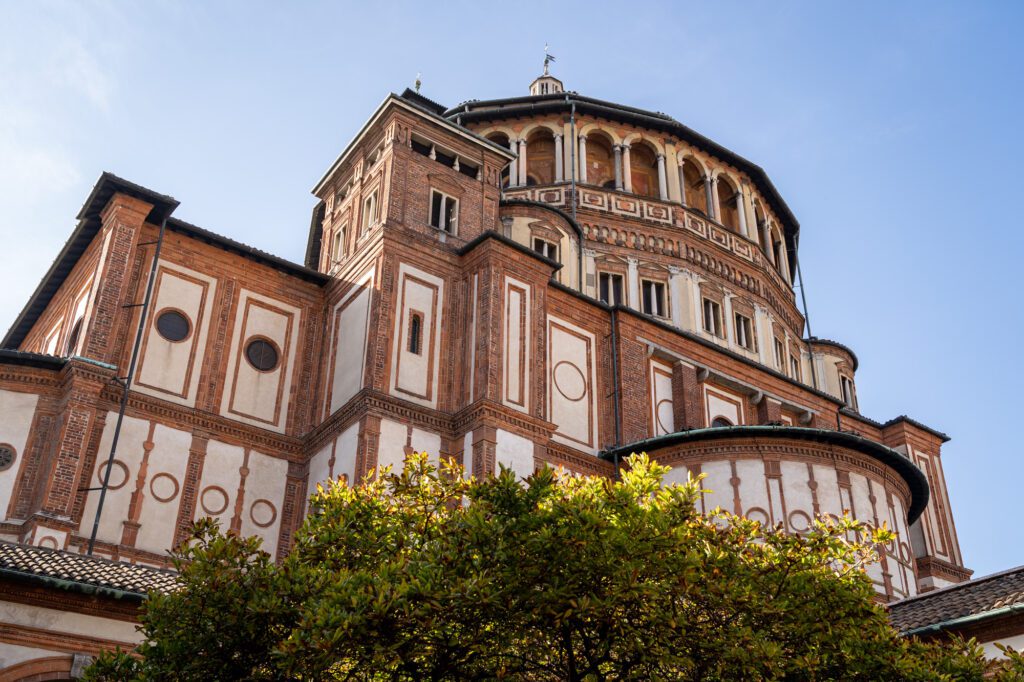
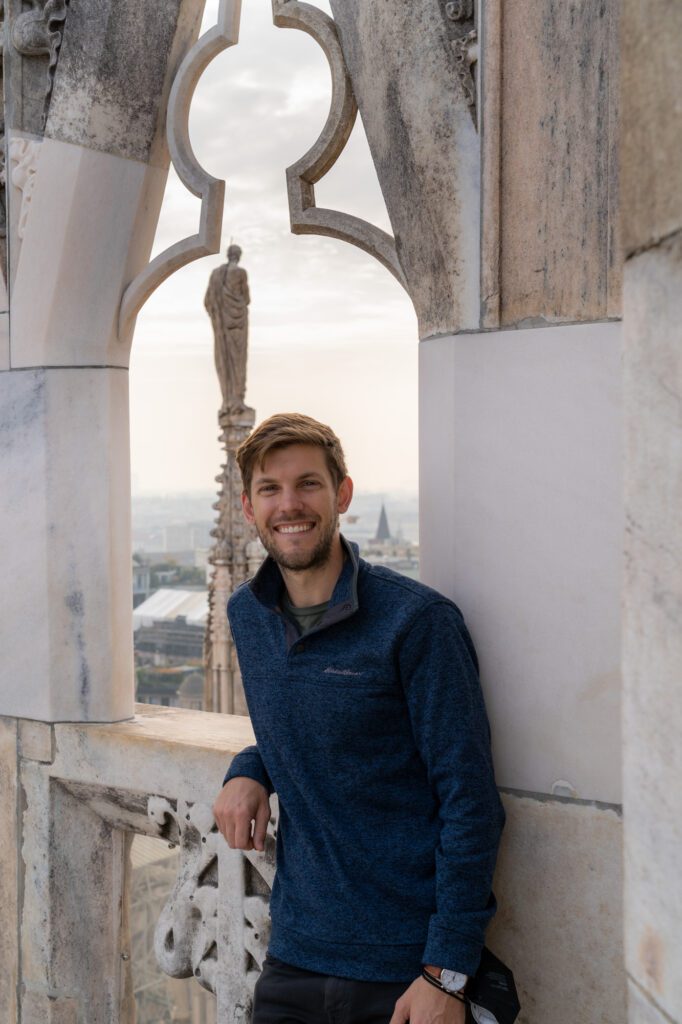
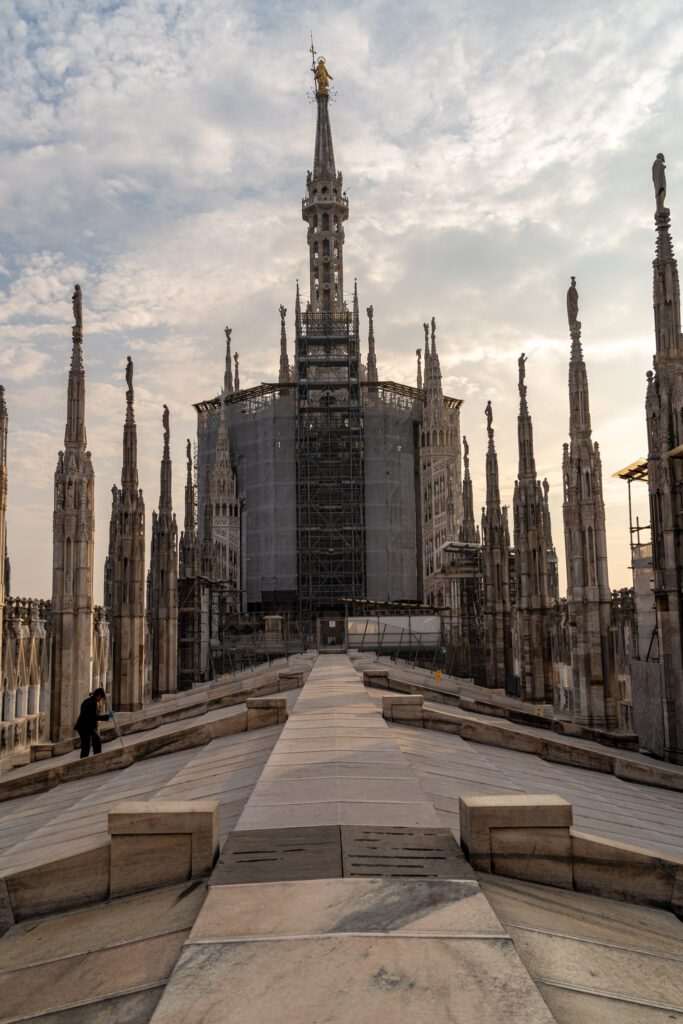
Disclaimer: Some of the links in this post, like hotel links, are affiliate links, meaning at no additional cost to you, we make a little bit of money if you click through and book. That being said, we would never recommend something to you that we don’t stand behind 100%.
How Many Days Should You Spend in Milan?
When we write our itineraries, we always start with a section about how much time to spend in whatever destination we’re writing about.
And, to be honest, the answer is always roughly the same: no, X days is not really enough, but if it’s what you’ve got we’re going to help you make the most of it.
It’s the same here in Milan. Two days is not enough to see everything there is to see in the city (or, importantly, the treasures like Lake Como and Turin that are just outside the city).
However, we think two days is a good balance because it allows you to break up the big attractions – the Last Supper and the Duomo di Milano – and hit them on separate days.
Sure, you could do them in one day (and we have an entire guide to spending one day in Milan to help you do it), but in our experience, we’re almost always exhausted after one major attraction, and two is too many.
For context, I (Matt here, the main voice behind the writing on this site!) have now been to Milan twice. Once for a little over 24 hours, and once for almost a week.
While I feel like I was able to get an overview with that first trip (I didn’t even make it to the Last Supper!), more time allowed me to uncover a few places that were relatively unexpected and unheralded, which I really enjoyed.
So, in short, Milan is a big, modern city, and you won’t be able to see everything in two days.
However, we do think that two days offers you enough time to hit the main attractions – the Duomo, the Last Supper, and the Parco Sempione – while saving time for some less heralded attractions and exploring some of Milan’s coolest neighborhoods.
If you’re wanting to add a day trip from Milan to, say, Lake Como, Torino, or Verona, then we’d make sure to add an extra day to your Milan itinerary for each rather than trying to fit it into two days.
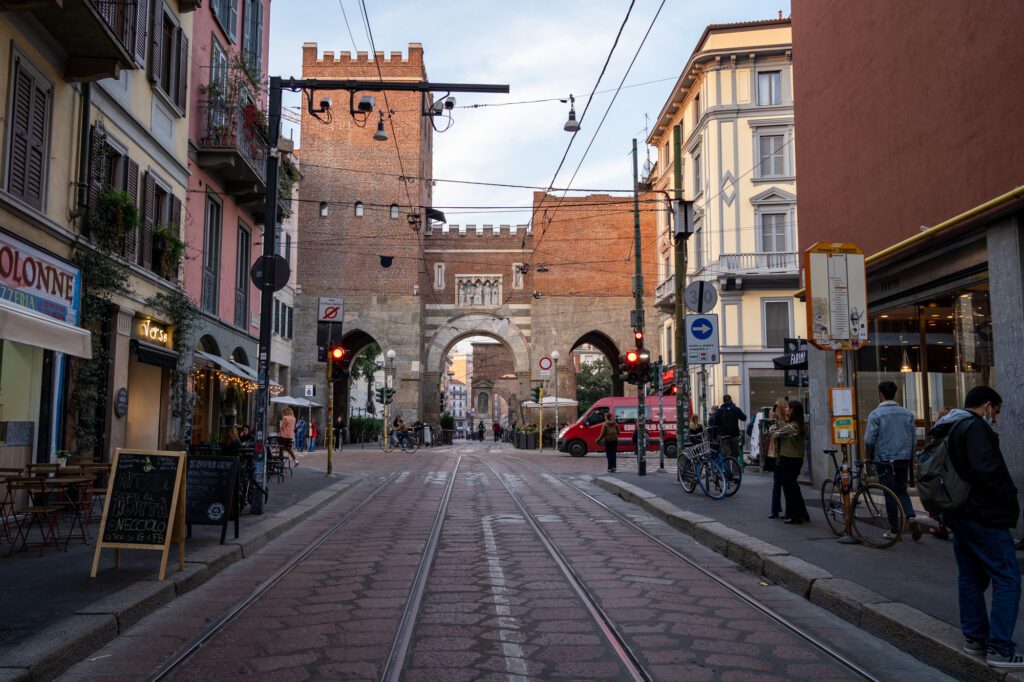
Where to Stay in Milan
With two days, we’re conflicted on which area to recommend for your trip.
So we’ll give you three, with a brief overview of their pros/cons and some cool places to stay that we’ve come across.
If you want the longer version, we have an entire guide to the best places to stay in Milan, which is a deep dive into choosing the right place to stay.
That’s the place to go for all the details behind the summaries in this section.
For what it’s worth, we’ve stayed at iQ Hotel (near Milano Centrale, Milan’s main train station), Ostello Bello Grande (also near the train station), and Casa Mia (near Porta Venezia) and highly recommend all three, which offer different things at different price points (for example, Casa Mia has a kitchen, which I valued on my solo trip).
At a high level, we think there are three areas that would make a good home base for your time in Milan, and it largely depends on your specific preferences.
If you want to be right in the middle of all the action, we’d avoid staying near the Duomo and opt for nearby Brera instead, which is within walking distance of all three main attractions in Milan, but removed from the hordes of tourists at Piazza del Duomo and Galleria Vittorio Emanuele II.
You’ll pay for the location, and it’s a fairly upscale neighborhood, but the location is worth the price we think given Milan’s spread out nature.
Urban Hive Milano is our top pick in the neighborhood, and is probably where we’ll stay on our next trip. It’s stylish, and it’s not the cheapest option (and, importantly, not the most expensive either).
If you want to be in a utilitarian, convenient neighborhood, consider staying near Milano Centrale (which is likely where you’ll be arriving in Milan). It’s not the sexiest neighborhood – you’ll want to look elsewhere for food and drinks – but it’s the transportation hub of the city with good metro and tram connections.
For what it’s worth, we stayed in this area. Twice. And enjoyed it overall.
On our first trip we stayed at Ostello Bello Grande, a very nice hostel a block away from the train station with a lovely rooftop patio and both bunks and private rooms (we chose the latter).
On my latest trip, I stayed at Hotel IQ with my mom and brother, and it was also great – comfortable beds, friendly staff, and a good value.
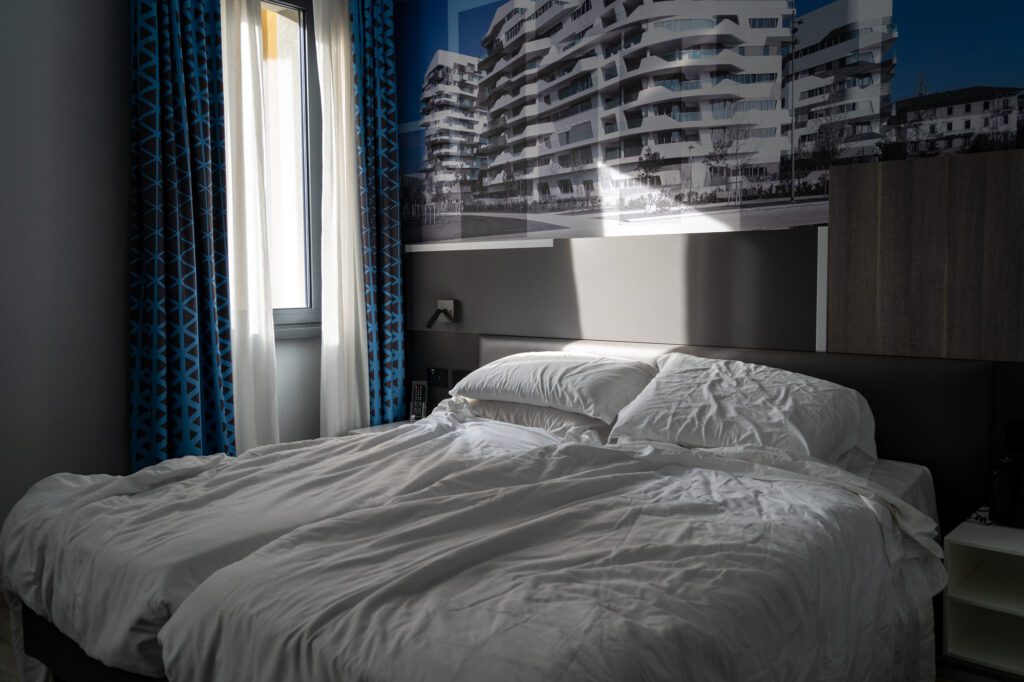
If you want to stay in what we think is Milan’s coolest neighborhood, look south to Navigli, Milan’s mini-Amsterdam.
This is our favorite part of the city, and the canals are fun and unexpected, and the neighborhood is lively and full of good places to eat and drink.
It’s the least convenient of the three, though, since it’s on the opposite end of the city from Milano Centrale, which may or may not be a deal breaker for your relatively short trip.
Look at Combo Milano if you’re on a budget, or Aethos for the coolest hotel in the neighborhood.
2 Days in Milan: An Itinerary for First Timers
And now, onwards and upwards to the itinerary!
This guide covers the top attractions and activities that definitely shouldn’t be missed on a 48 hour trip.
You’ll also find plenty of practical information, including how to visit each attraction and the best way to book tickets, etc.
For this itinerary, we’re assuming that you have two full days in Milan, which likely means arriving the night before and leaving either on the second evening, or the next morning.
If you have less than two full days, you’ll have to do some slight reworking.
Here is a high-level overview of what this itinerary looks like:
- Day 1: Coffee, Walking Tour, Duomo Complex, Galleria Vittorio Emanuele II, Teatro alla Scala, Castello Sforzesco, and Parco Sempione.
- Day 2: The Last Supper, The Ambrosian Library, Lunch at a Local Deli, Basilica San Lorenzo Maggiore, and Dinner and Drinks in the Navigli District.
Day 1 : A Walking Tour, the Duomo, and Parco Sempione
On your first day in Milan, spend the morning getting your bearings on a walking tour of the city with a local guide.
Then use the rest of your day to explore the highlights of the extensive Duomo Complex, as well as some of Milan’s top historical sights, including the Teatro alla Scala and Castello Sforzesco.
But First, Coffee
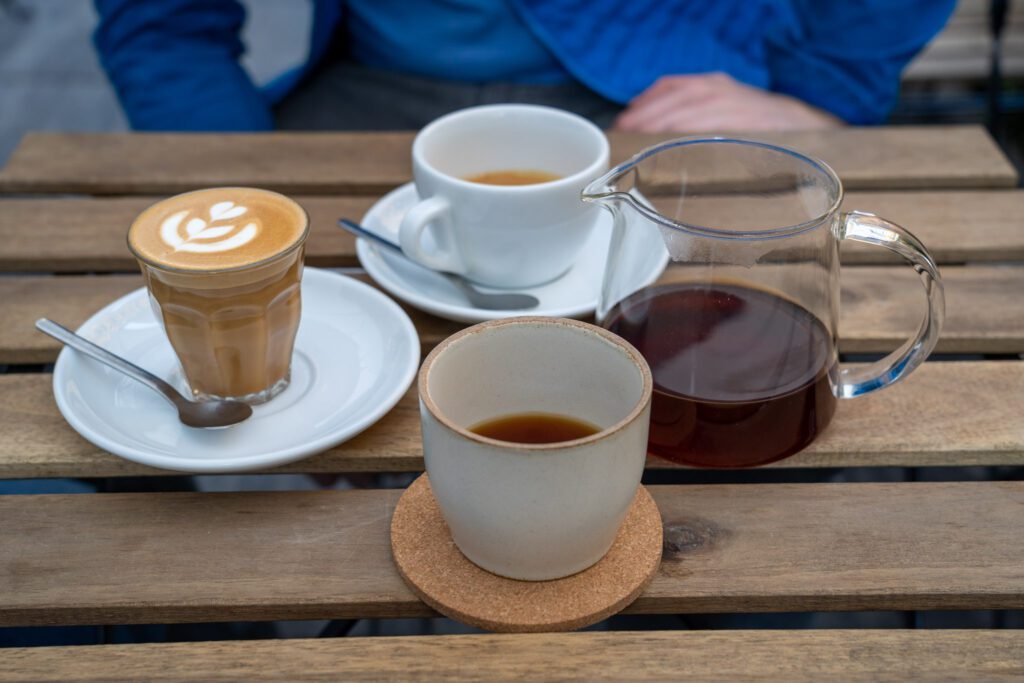
Start your first day in Milan the proper Italian way… with great coffee! You’re going to need it before a busy day of exploring the city.
Now, there are countless places to get good coffee in Milan, especially if you’re looking for a more traditional espresso-at-the-bar experience.
However, if you’re like Matt and are looking for excellent specialty coffee, Milan also has you covered. Here are three places we’d highly recommend.
- Orsonero: A specialty coffee shop in a somewhat residential area near Porta Venezia in the northeast corner of the city center (sort of near Milano Centrale). They usually have coffee from legendary Italian roaster Gardelli along with a rotating cast of other coffee characters. It’s a lovely location on a quiet corner across from a park.
- Loste: A modern take on the traditional Italian cafe and bar, with great specialty coffee and tasty homemade pastries made fresh each morning. It’s a little out of the way (east of the city center), but is worth the journey (particularly for the pastries, which are NOT gluten free, but look incredible).
- Nowhere: If you decided to stay in the southern end of the center near the canals, this is the spot! It’s a very Insta-friendly specialty coffee shop (think bright colors and fun fonts) with freshly roasted single-origin coffee. Also serves a good brunch, if you’re looking for food before you head out exploring.
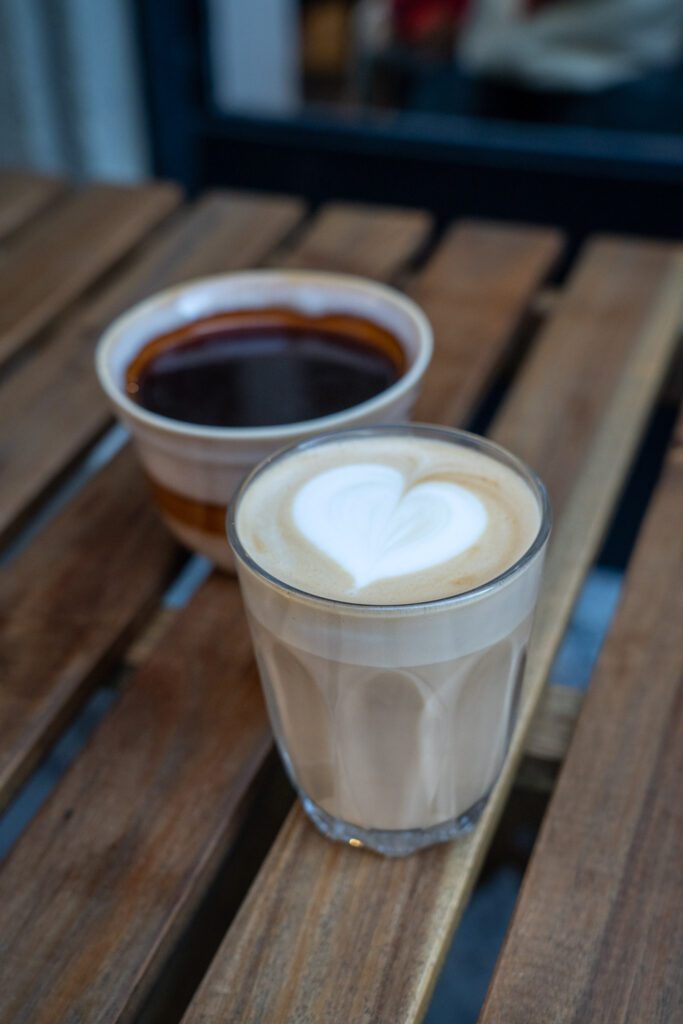
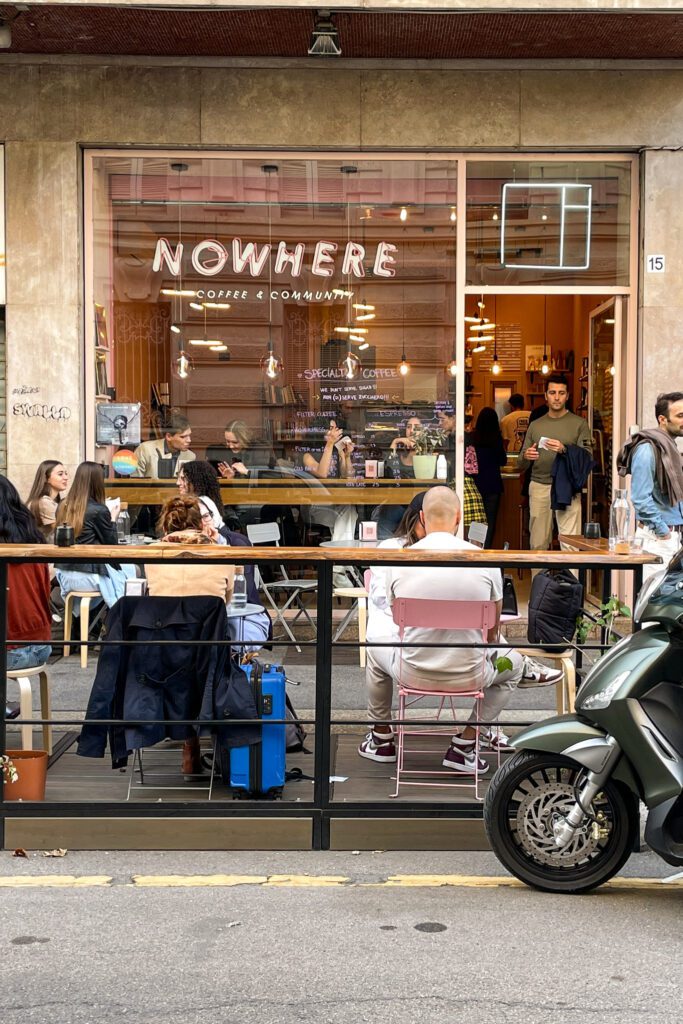
Get Oriented with a Walking Tour
We always try to start a visit to a new city with a walking tour. A tour helps you to get oriented.
Plus, you can connect with a local and ask questions like “what should we eat” and “what’s something that gets overlooked that we should definitely do?”
We did this one with a journalist-turned-historian and loved it. On the two-hour tour (9:00-11:00am), we learned about Milan’s history and architecture and heard stories of the city from a local’s perspective.
It covers a lot of ground, including the park, the exterior of the Duomo, and the historic center, and will serve as a nice overview of the city.
We also really love WithLocals, which we’ve used to organize private walking tours with passionate local guides in multiple cities (but not Milan…yet). It’s a better value if you have a group of three or four (or more).
The Duomo di Milano (Terraces + Interior)
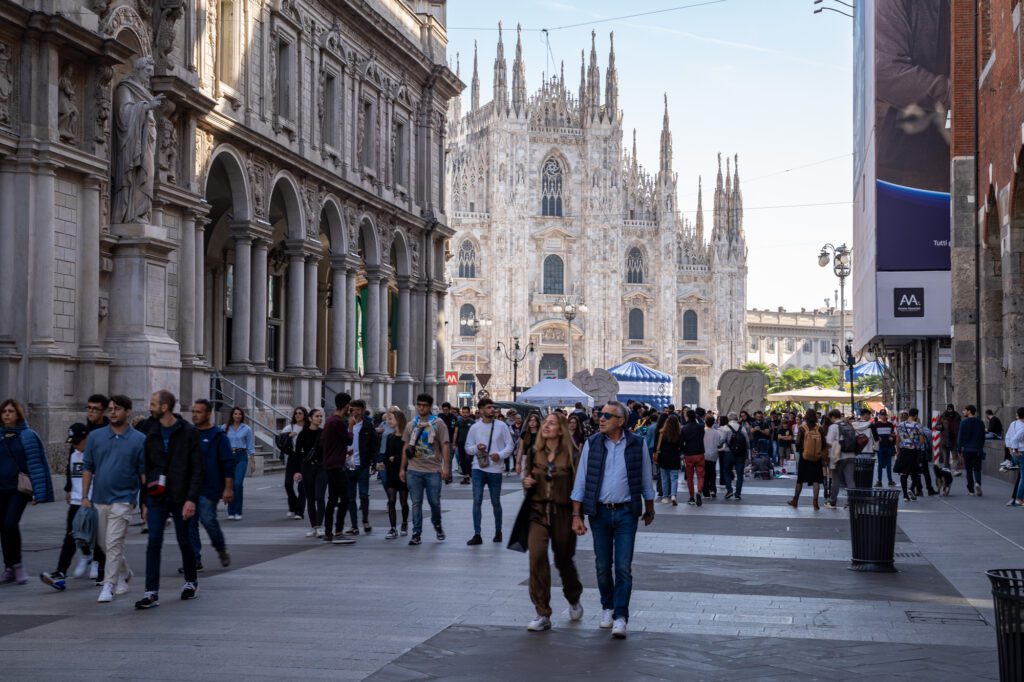
If you didn’t already know, the mighty Milan Cathedral is the biggest church in Italy and the third biggest in the world! It’s the city’s most prominent landmark, and a visit is a must-do for anyone visiting Milan.
This is where I first discovered that Napoleon was crowned king of Italy at one point at the Duomo, which led me down a rabbit hole of devouring podcasts and audiobooks about the emperor-turned-outcast.
The construction of Milan’s Duomo began in the 14th Century and took over six centuries to complete.
The construction process was interrupted multiple times, mostly by different groups ascending to power or occupying the city.
It was actually Napoleon who helped push the efforts to finally finish the cathedral in the 19th Century.
Due to the prolonged completion time and involvement of numerous architects over the centuries, the cathedral’s architectural style is incredibly diverse and scattered.
The unique structure is difficult to place into one specific era, with a variety of Gothic, Baroque, Renaissance, and Neoclassical decorative elements.
Centered around Piazza del Duomo, the huge Duomo complex features several different areas that you can visit.
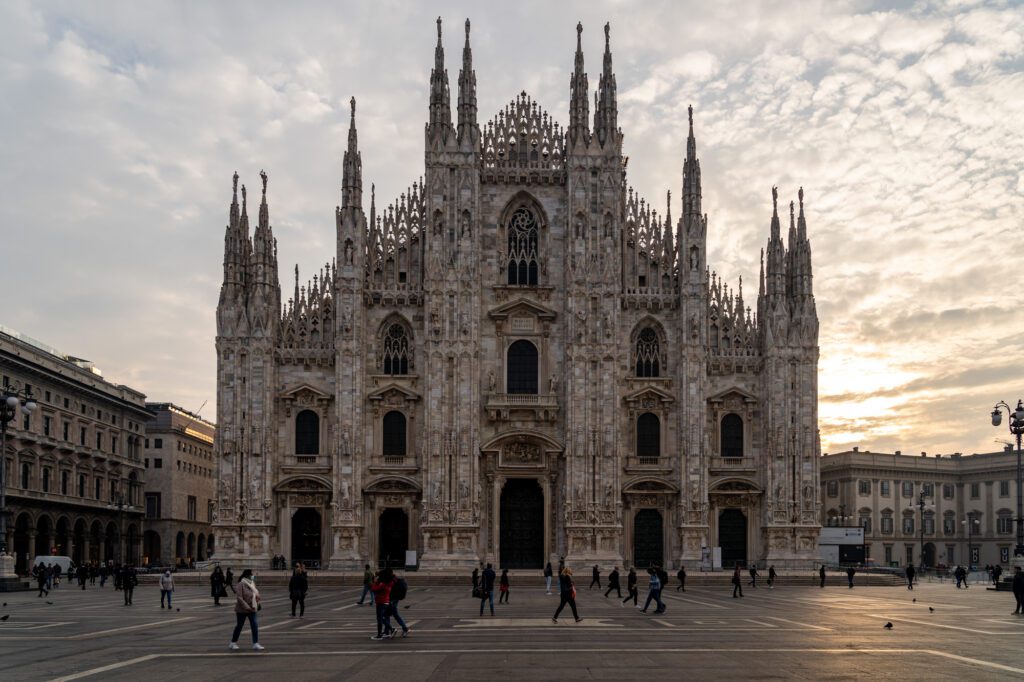
These include the cathedral itself, the terraces, an archaeological site, a museum, and the Church of St. Gottardo in Corte.
There’s so much to see and do in the Duomo complex that you could easily spend the best part of a day exploring it all.
But with just two days, we’d recommend limiting your visit to a couple of hours and using your saved time to explore elsewhere.
The two areas of the Duomo complex we’d recommend focusing on are the terraces and interior.
The Duomo Terraces
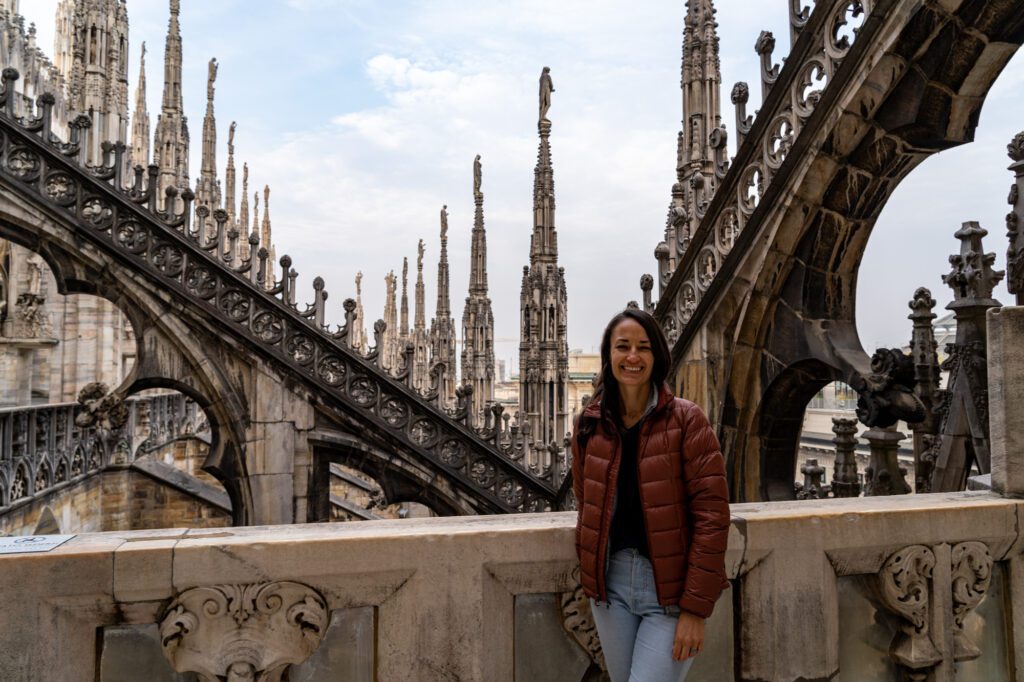
The Terraces are the real highlight of the entire Duomo complex for us. They’re the most unique aspect of the Cathedral and should be the main priority on your visit.
You can access the Duomo Terraces either by climbing a long, narrow flight of stairs (it’s not too bad really) or by paying a little extra to take the elevator up.
A visit to the Terraces offers an up-close-and-personal view of the unusual gargoyles, ornate sculptures, and amazing architectural details of the unique Cathedral that are difficult to see from Piazza del Duomo below.
For example, did you know there are figures standing on top of each of the cathedral’s spires? And not all of them are fully clothed, which is an odd choice for a cathedral, but we’re here for it.
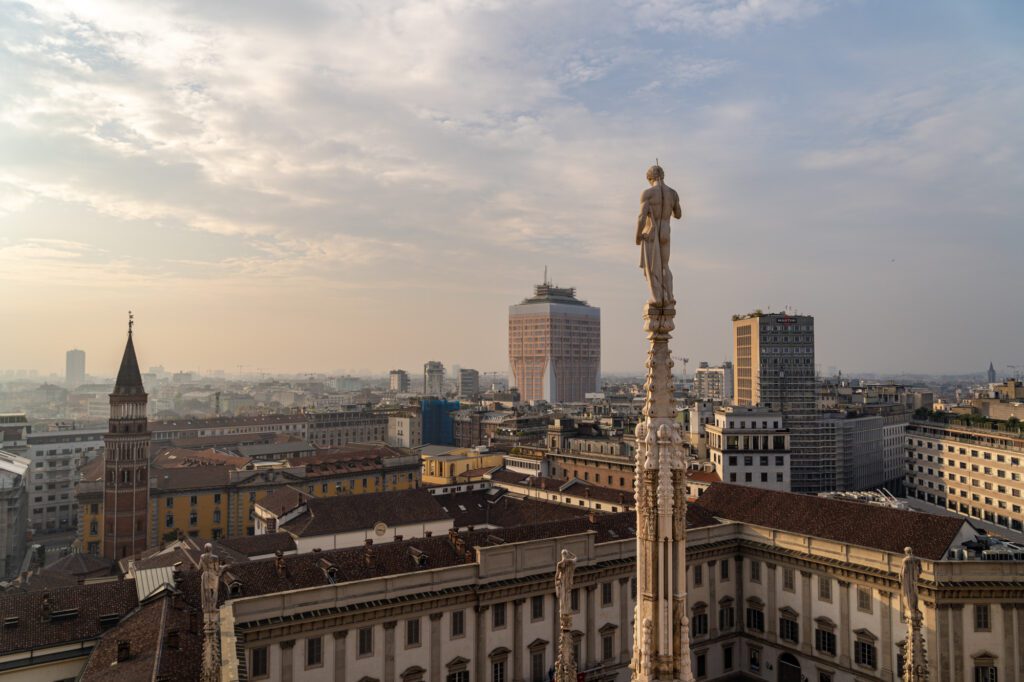
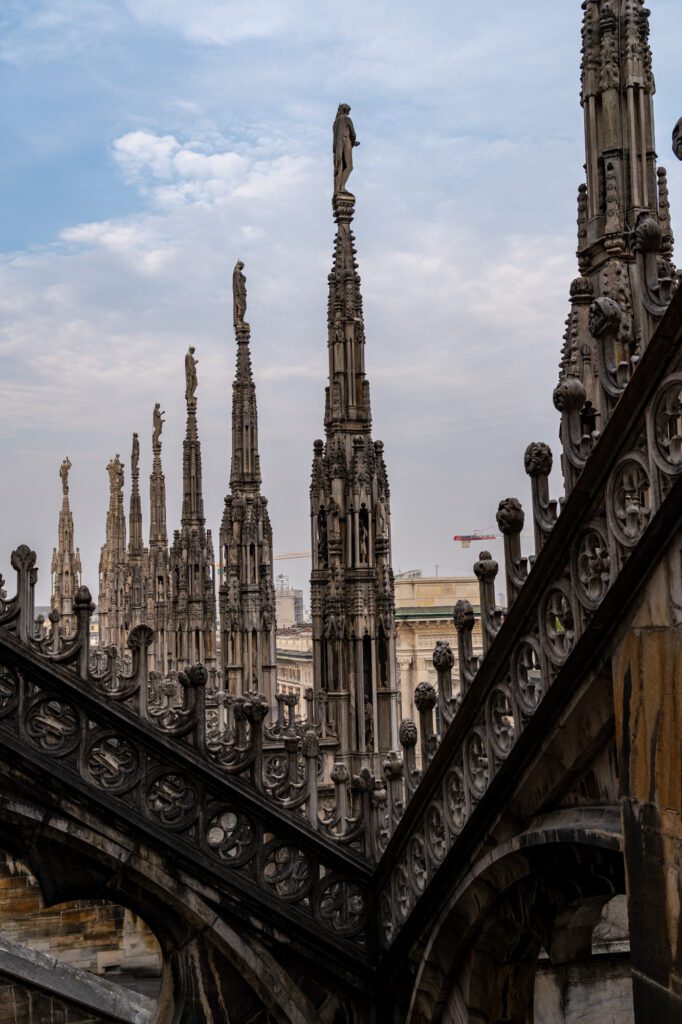
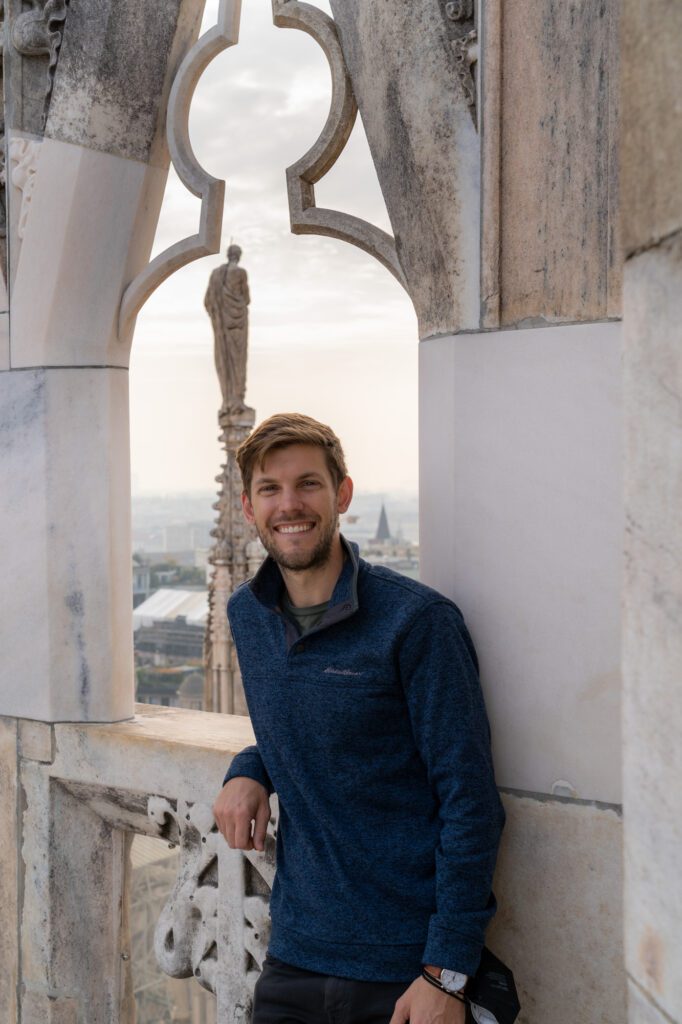
This is also where you’ll find one of the absolute BEST views in all of Milan.
The rooftop Terraces offer amazing panoramic views over Milan’s skyline, allowing you to admire the contrast between the historic cathedral and the many modern buildings that surround it.
The Duomo Interior
We should first note here that we are not “visit all the churches” people. We’d rather spend our time elsewhere when exploring a city. Which is why you won’t find many churches in this Milan itinerary.
But, if you are going to head inside a church in Milan, it should be this one.
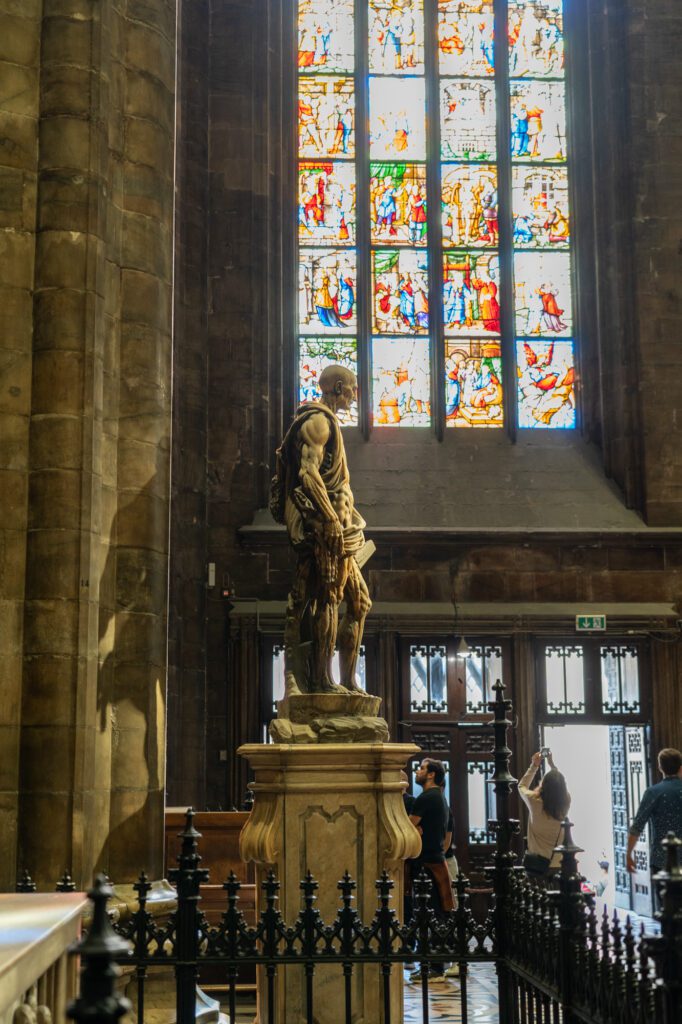
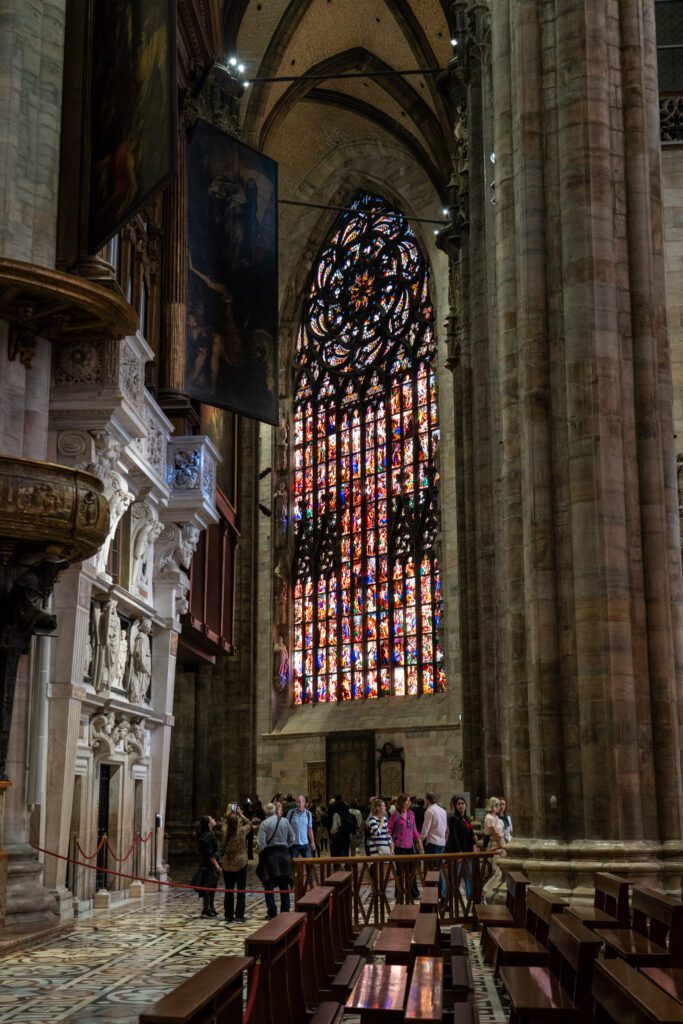
The Duomo interior is worth seeing for its enormous size, as well as the huge frescoes, intricate stained glass windows, and lifelike statues.
Other than that, it’s pretty similar to most other churches in big Italian cities.
You’ll only need 10-15 minutes inside to admire the interior of the Cathedral. Focus more of your time on visiting the Terraces.
Getting Tickets for the Duomo
There are a few different ways of getting tickets for the Duomo.
The first is to book directly through the Duomo website. There are multiple different ticket options to choose from, including Terrace access only or combined tickets for the whole complex.
For access to the terraces by stairs + interior (like we’re recommending), you want the “DUOMO TERRACES MUSEUM- STAIRS” variety.
Or you can book through Get Your Guide for a more streamlined process. This Cathedral and Rooftop ticket gets you access to all areas of the Milan Duomo, as well as the use of an audio guide.
The final option is to join a guided tour of the Duomo. This Duomo tour takes you on a two hour visit to explore the Cathedral and Terraces, including fast-track entrance and a knowledgeable local guide.
Tips for Visiting the Duomo
A few things you need to know before visiting Milan’s Duomo.
- Cover Up – Remember, the Duomo is still a working church, so you’ll need to cover up. You will be denied entry if your shoulders and knees are not covered. Dress accordingly or bring extra layers with you if it’s a hot day.
- Book Fast Track – If you’re visiting during a busy period, consider booking a fast-track ticket to avoid the long lines. The Cathedral can get seriously busy during summer and other peak times.
- Stairs or Elevator? – To reach the terraces, you’ll need to climb a steep narrow staircase with roughly 200 steps. We did it, and it really wasn’t too bad. But if you struggle with stairs, consider taking the elevator instead.
Galleria Vittorio Emanuele II
Before you leave Piazza del Duomo, take a quick walk through Galleria Vittorio Emanuele II.
The luxurious mall is one of the most impressive in Milan (if not the entire country), with a beautiful design, many intricate frescoes, and plenty of high-end shops such as Gucci, Prada, etc lining its walkways.
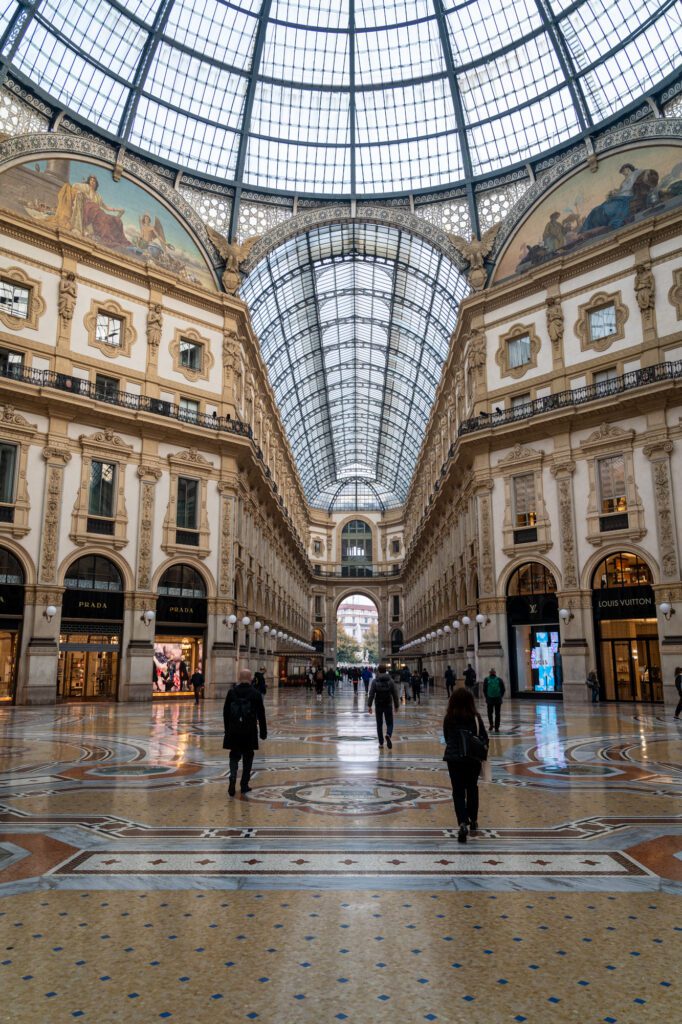
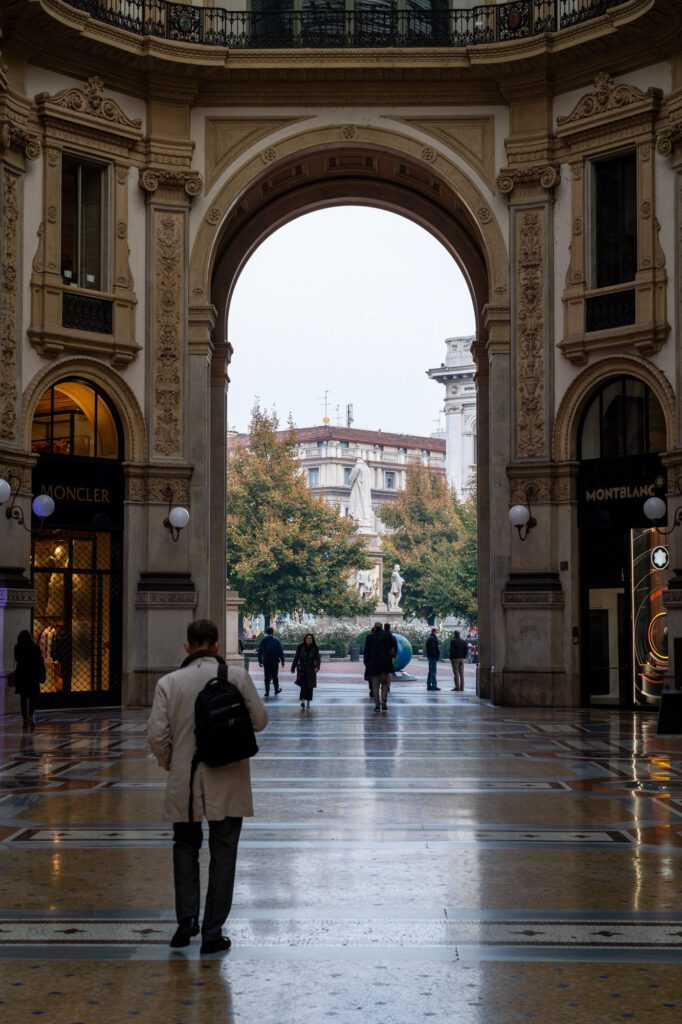
Stand in the center and make sure to look up to admire the four frescoes just under the roof.
The mall does get pretty busy, and many of the shops are a little out of most regular people’s budgets, so you’ll only need 10 minutes or so to take it all in.
Wander through and find the exit that leads you out onto Piazza della Scala.
Teatro alla Scala
Located on the opposite side of Galleria Vittorio Emanuele II to the Duomo Complex, Teatro alla Scala is Milan’s iconic 18th-Century theater.
The historic theater is known for its opulent design and for hosting Italian opera and ballets. It’s often hailed as one of the most beautiful theaters in the world.
While you won’t be taking a trip to the opera in the middle of the day, it’s still certainly worth stopping by the lavish theater.
From the outside, you can admire the statue of Leonardo Da Vinci and the theater’s impressive exterior. But to see the famous interior, you’ll need to pre-book a ticket or a guided tour (if you’re not seeing a performance that is).
A standard entrance ticket can be purchased through the theater’s official website. A ticket costs €12.96 per adult and gets you access to the theater museum, which has a collection of costumes and musical instruments from the theater’s history.
From the museum, you can catch a glimpse of the theater itself from the boxes.
Alternatively, to add some more depth to your experience, book a guided tour of the theater.
You can book a guided tour through the theater’s website. The official tours are cheaper than most private tours, but they only run once per day in each language, so may be harder to fit into your schedule.
You can also book a guided tour through a private tour company. There are plenty of companies offering small group tours through sites such as Get Your Guide, meaning more flexible timings.
Most guided tours last around an hour and take you to explore the theater and museum, while uncovering the secrets of its design and long history.
If opera is your thing, you could always skip the tour and return on one of your evenings to catch a performance.
There are shows taking place most nights of the week – find the full show schedule here.
Parco Sempione and Castello Sforzesco
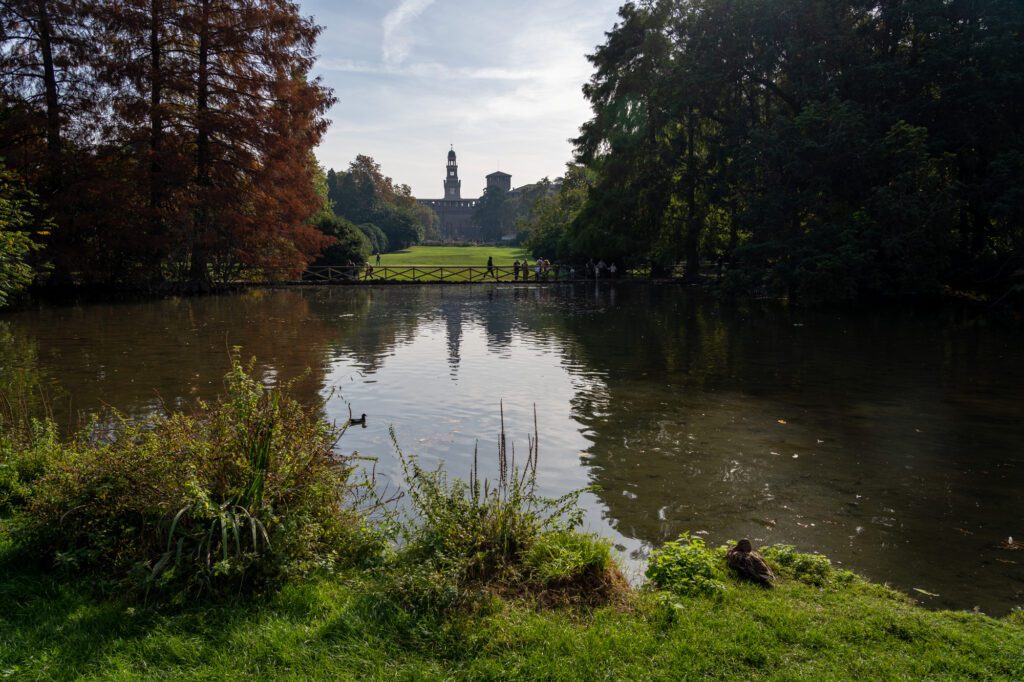
Your final stop of day one will give you a glimpse into Milan’s Medieval history.
Castello Sforzesco is a large Medieval-Renaissance fortress. It was first built in the 14th Century by the Duke of Milan, before being transformed into a private residence by the Visconti Lords.
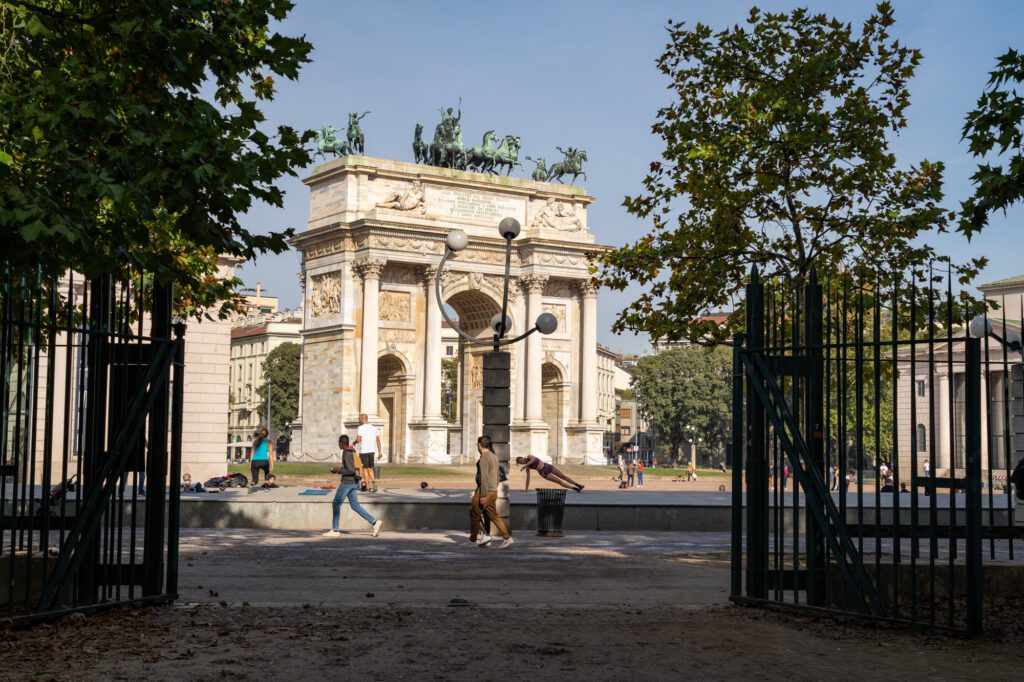
The Lords invested lots of money in decorating the castle with the highest quality art imaginable – including many frescoes by Leonardo da Vinci.
Today, the castle is home to numerous museums, including the Pinacoteca del Castello Sforzesco, the Archaeological Museum of Milan, and the Rondanini Pietà Museum (showcasing Michelangelo’s last work).
Entrance to all of the museums is included in a single €5 ticket. If you have a couple of hours to spare and enjoy exploring museums, it’s pretty good value.
Once inside, you can also walk the castle ramparts for some nice views of the city.
Personally, we don’t think the museums are a “must-do” in Milan.
If, like us, you’ve already visited your fair share of museums across Europe, we’d suggest skipping them and enjoying the castle from the outside instead. The castle grounds and courtyards are completely free to visit.
After you’ve finished at Castello Sforzesco, take a stroll through the surrounding Parco Sempione, the largest green space in Milan.
It reminds us of Golden Gate Park in our former home of San Francisco, or Central Park in New York.
It has museums, locals walking their dogs, group fitness classes, and – since every European city needs one – an arch.
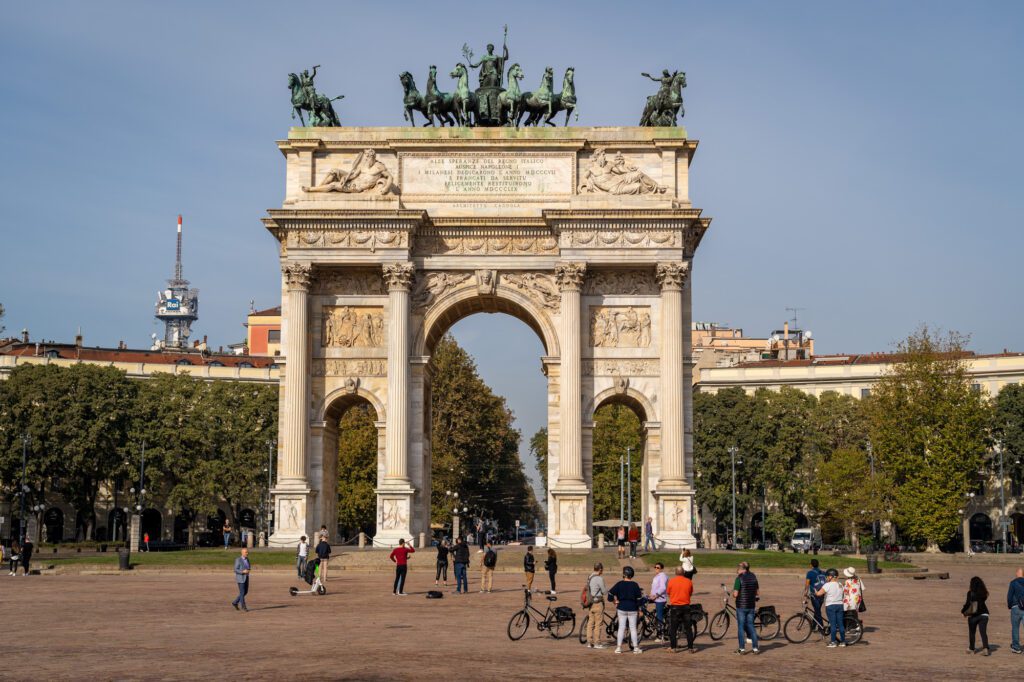
Walk through the huge park from the castle to the Arco della Pace.
Make sure to stop by Ponte delle Sirenette, which is a bridge with mermaid statues on either end. Find it here on Google Maps.
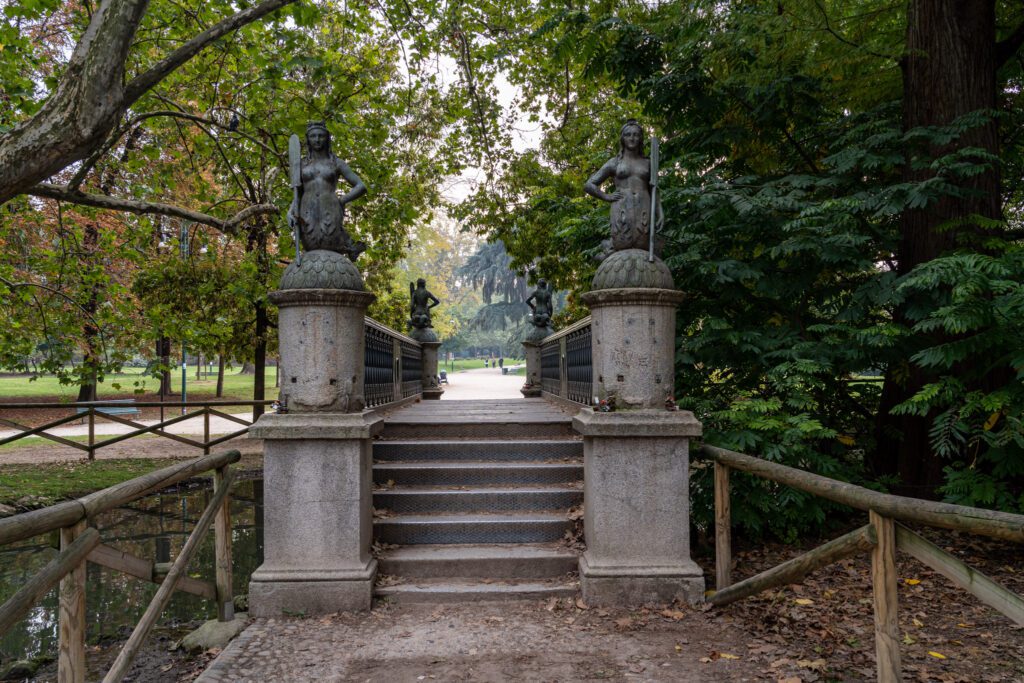
Day 2: The Last Supper, Leonardo Da Vinci, and Milan’s Canals
On your second day in Milan, start with a visit to Santa Maria delle Grazie Church to catch a glimpse of the famous The Last Supper, before heading to The Ambrosian Library to see some of Leonard Da Vinci’s original sketches.
After lunch, check out the ancient mosaics of Basilica San Lorenzo Maggiore and the Roman columns of Colonne di San Lorenzo.
Then end your day in the Navigli District for dinner and drinks by the canals.
Seeing the Last Supper
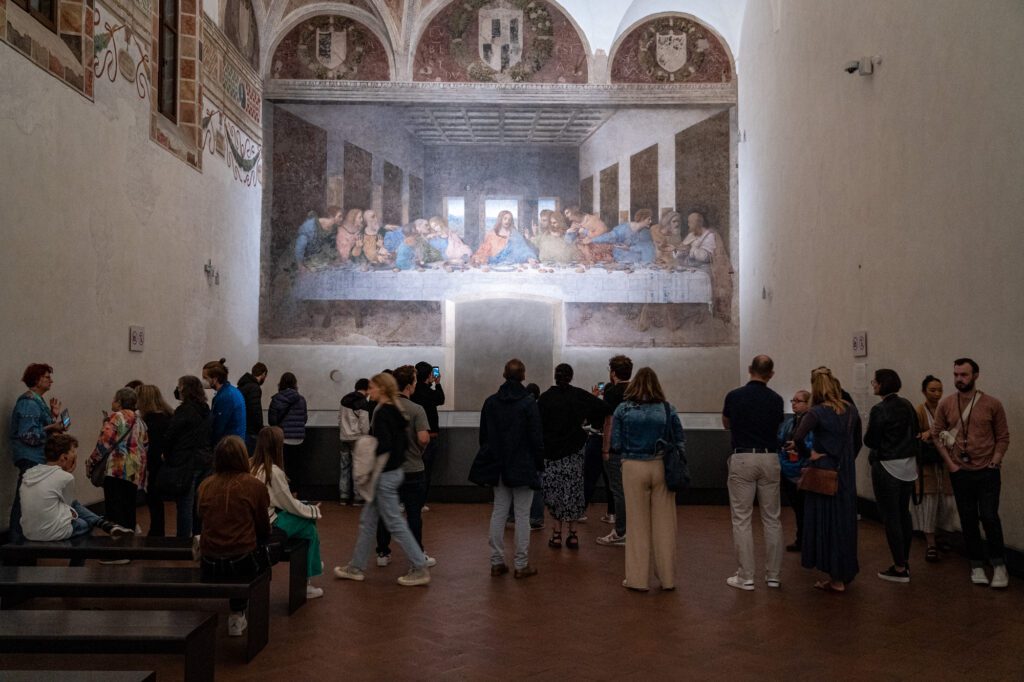
Located inside a small church in central Milan, The Last Supper is one of the most famous paintings in the world.
Painted in the late 15th Century by Leonardo Da Vinci, the artwork depicts Jesus having a last supper with his disciples.
The depicted scene is notable because Jesus tells them that one of them will betray him. And – SPOILER ALERT – sure enough, Judas does.
The Last Supper is definitely worth seeing. BUT, unfortunately, it’s not the easiest Milan attraction to visit.
The painting is located inside Santa Maria delle Grazie Church, with heavily limited crowds to protect the art. Visits are offered in 15-minute time slots, with only 25 guests per slot.
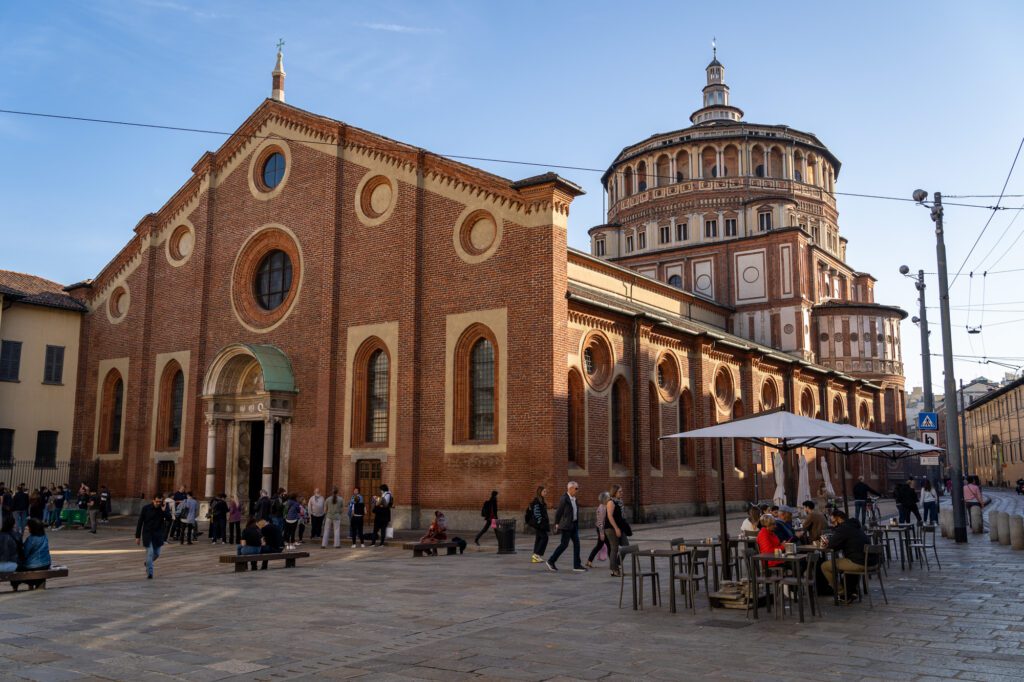
This is not a lot of people when you consider how many thousands of tourists come to Milan each day, most of whom want to see the famous painting.
Getting tickets becomes even more difficult when you account for tour companies getting first crack at them, leaving very few for independent travelers.
On our last trip to Milan, I was with my mom and brother and seeing the Last Supper in person was on my mom’s bucket list.
Unfortunately, I completely missed the window to buy tickets ourselves and visit independently, but the tour we did (it was this Walks of Italy tour) was excellent, and included a walking tour to the Duomo that covered a few spots that we never would have discovered on our own.
We have a few solutions for you, ranging from “I’m on top of it and ready to book six months in advance” to “oh shoot, I completely forgot and it’s the day before I get to Milan – HELP!”
Below we’ll run you through our tips for getting tickets to see The Last Supper. At a high level, you have two options: snagging tickets on your own, or joining a guided tour.
Getting Last Supper Tickets Independently
Getting independent tickets is the most reliable method, but also the most difficult and confusing.
Tickets are available here on the official website.
Tickets are released sporadically up to 3 months in advance. During the peak summer period, tickets sell out almost immediately. Even during the off-season, weekend tickets still tend to sell out.
As soon as you know which dates you’ll be visiting Milan, you’re going to need to keep checking the ticket website and try to book as far in advance as possible!
Tickets cost €15 per adult. Reduced-price tickets are just €2 (for EU residents 18-25), and tickets for minors are free (you still need a reservation, though).
When purchasing tickets through the official website, you’ll need to create a MY-VIVATICKET account.
Even after booking online, you’ll still need to show up at the ticket office at the church at least 15 minutes before your time slot to redeem the tickets.
There can be long lines to pick up tickets, so make sure to account for that and show up early.
Join a Guided Tour
If you’ve booked your trip last minute and there are no independent tickets left for your dates, there’s no need to lose faith completely.
The good news is there are still ways to see the painting. The bad news is that it’s going to be quite a bit more expensive because you’ll need to join a tour.
There are two options for taking a guided tour of The Last Supper. These are joining a tour that only covers the Last Supper (like this one), or joining a broader Milan walking tour that takes you around to multiple sites (like this one).
Because we booked super last minute and it was on my mom’s bucket list, we went on this tour with Walks of Italy, which was great.
We’ve done many tours with Walks of Italy at this point (you can read about our incredible experience on their Colosseum Tour in Rome), and they’ve been nothing but excellent.
In general, we HIGHLY recommend guided tours of museums because the context and stories you get from an expert guide really enhance and enrich the experience, at least for us, and help us figure out what to focus on and care about in a sea of gorgeous pieces of art.
However, it’s a little different here, because there’s exactly one painting to see.
I will say that our guide did a great job bringing extra context to the picture, and we learned quite a bit about the history of the Last Supper (they pulled out all the stops to protect it from bombing in World War 2).
Our point is that you’re not just getting scammed out of extra money on a tour – the tour guide will elevate the experience (usually, anyway) and help you gain a deeper understanding of what you’re seeing.
Tips for Visiting the Last Supper
A few things you need to know before visiting the Last Supper and Santa Maria delle Grazie.
- Cover Up – The painting is located inside a church, so make sure your shoulders and knees are covered.
- No Bags – You can’t take bags into the church so you’ll need to check them beforehand. Leave extra time for this.
The Ambrosian Library (Leonardo Da Vinci’s Sketches!)
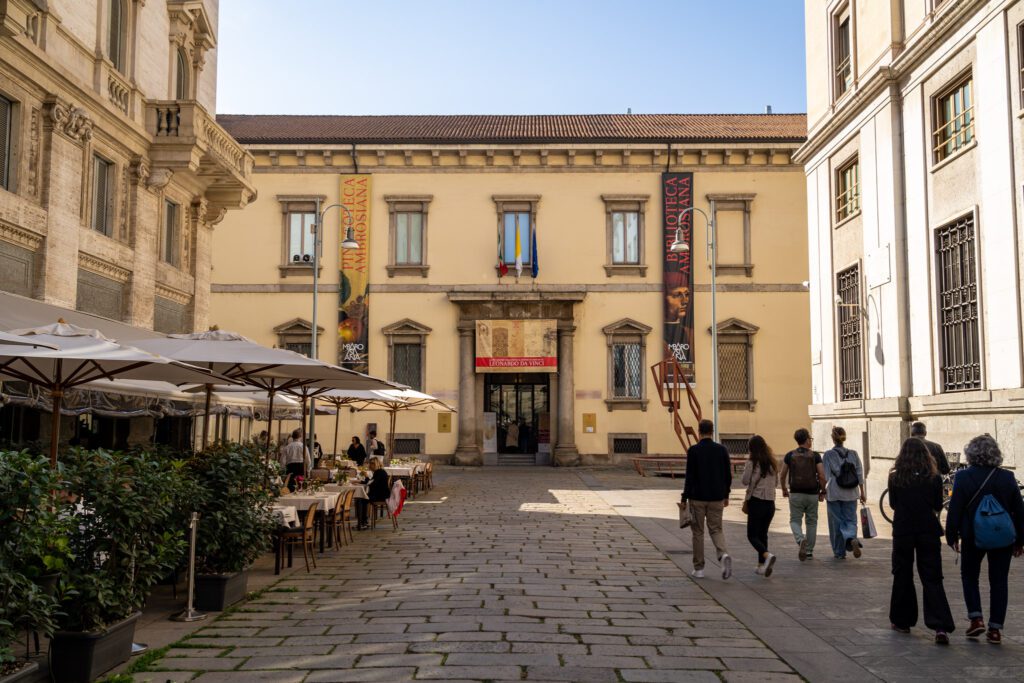
This was one of those things that came up when we asked our tour guide what’s something that most people overlook in Milan.
The Ambrosian Library was one of Europe’s first public libraries, dating back to 1607.
Today, it’s home to an extensive book and art collection, with works from a wide variety of well-known artists, including original sketches by Leonard Da Vinci.
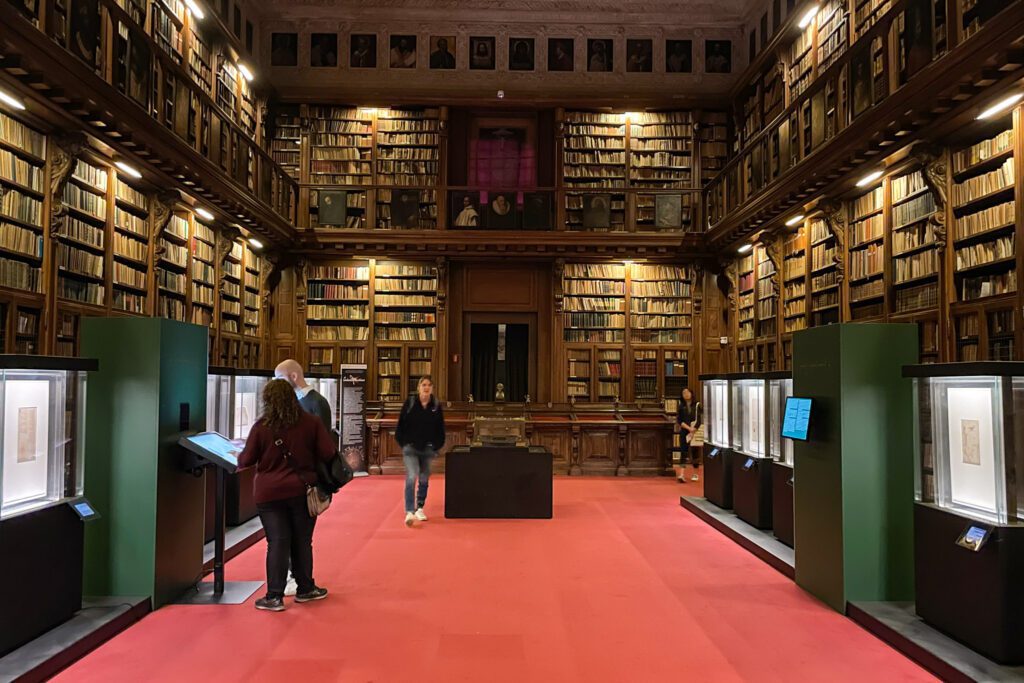
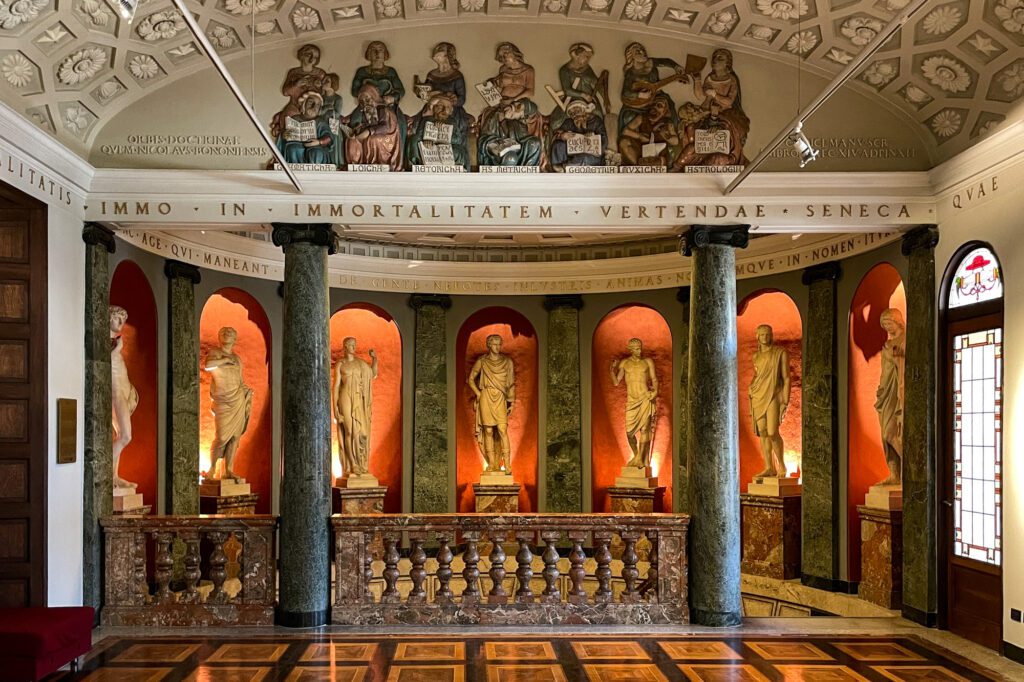
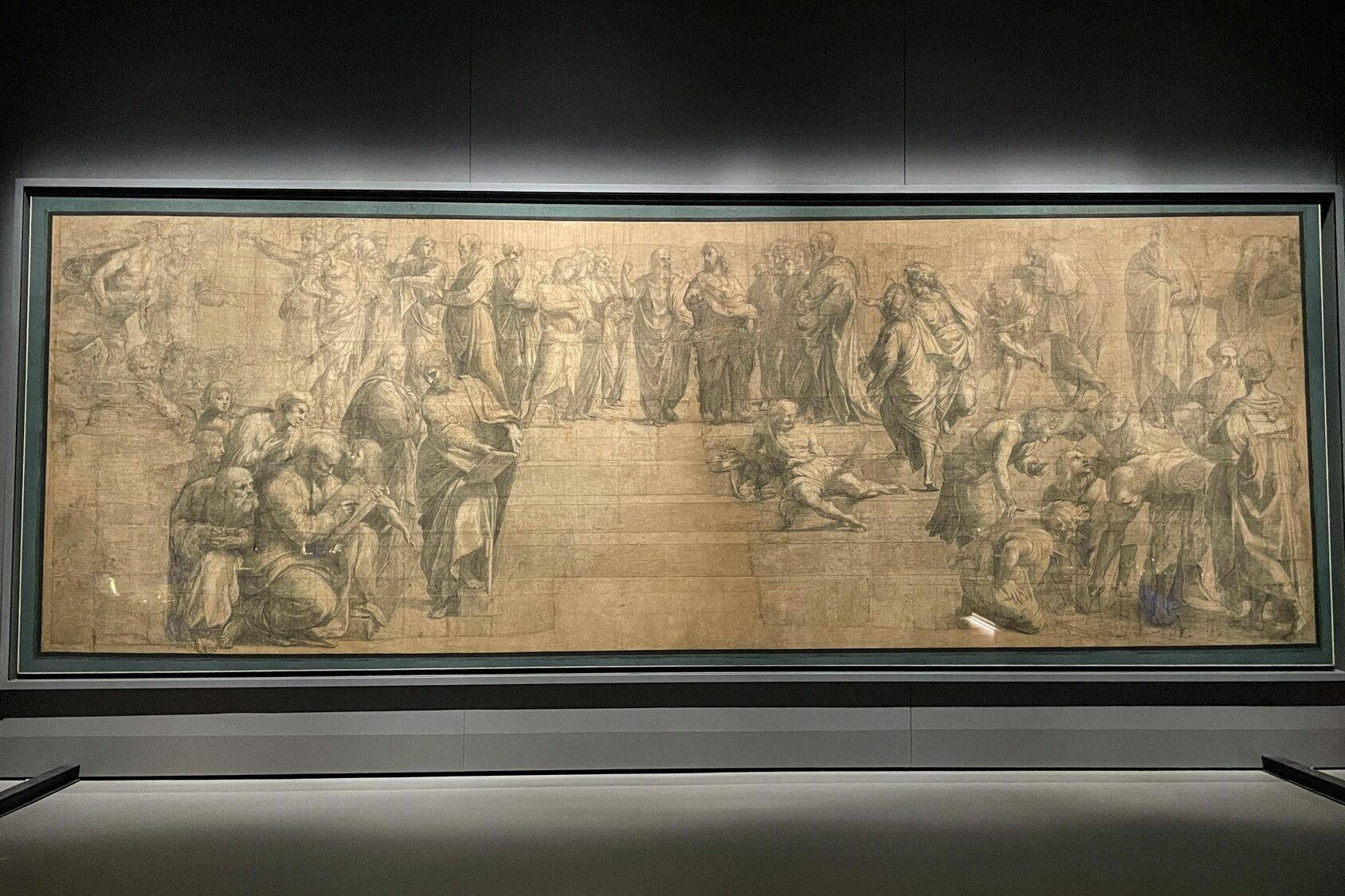
That’s essentially the entire reason I decided to go, and I really enjoyed it. It’s a more compact museum than most, so it’s not going to take up an entire day.
You can purchase tickets to visit the library’s public gallery (Pinacoteca Ambrosiana) through the official website.
An adult ticket to the gallery costs €15. A visit will take you around an hour or so, depending on your interest.
Quick Pit Stop at Peck (a Famous Deli) and Gelato
Once you’ve finished at Ambrosian Library, head just around the corner to find the Milanese institution that is Peck.
Nicknamed “the temple of Italian gastronomy,” Peck is a large specialty Italian grocery shop and deli with a butchery, cold cuts shop, cheesemaker, artisan pasta factory, bakery, wine shop, and many other gourmet food stalls.
With its variety of colorful sights and amazing smells, a stroll around Peck is an absolute must for foodies!
You can either pick up some snacks from the market stalls or enjoy a sit-down meal from the on-site restaurant or gourmet cafe.
The restaurant is extremely popular and it may be difficult to get a table without a reservation during peak times. If you want to eat in the restaurant, it may be best to book in advance.
A couple of doors down from Peck, you’ll also find one of our favorite gelaterias in Milan, Ciacco Gelato.
The modern gelato store has a great range of traditional and unique flavors, including several vegan options. The pistachio is a must-try!
The line for Ciacco can get fairly long. But it moves quickly and is 100% worth the wait.
Another good lunch option is All’Antico Vinaio, a famous sandwich shop in Florence now with several locations in Milan, including one just a 4-minute walk from the Ambrosian Library.
Basilica San Lorenzo Maggiore
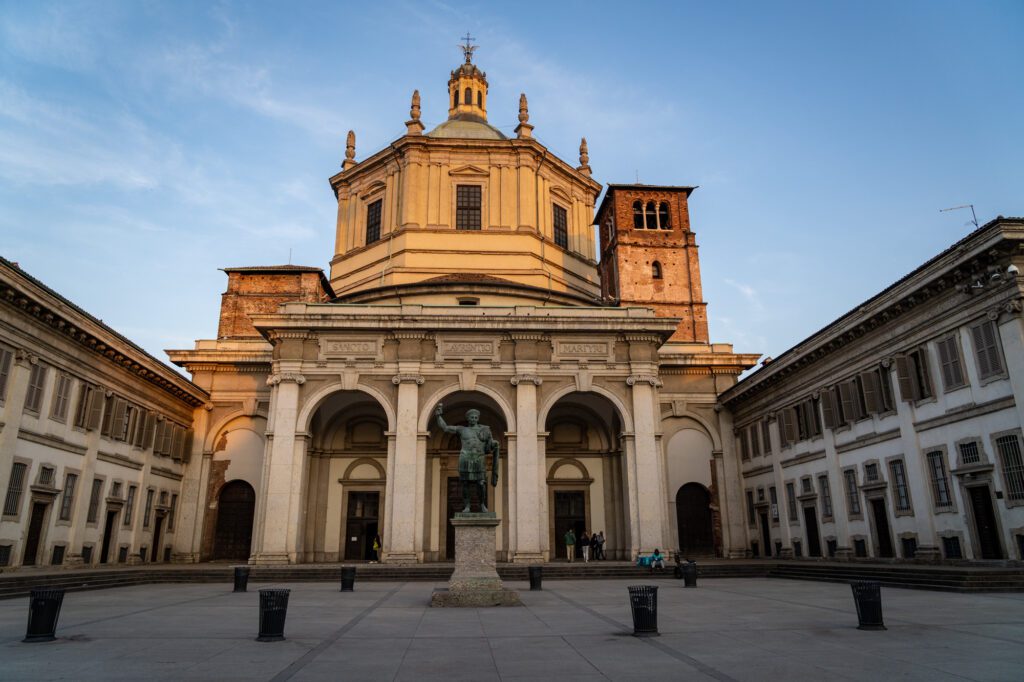
Basilica San Lorenzo Maggiore is an imposing Roman Catholic church sitting between downtown Milan and the Navigli District.
Originally built during the Roman period, it’s one of the oldest churches in the city. More than 1,500 years after its completion, the church remains a symbol of the legacy of the Roman Empire in Milan.
The church is completely free to visit, so it’s definitely worth a quick stop on your way down to the Navigli District.
The church’s interior is filled with amazing fourth-Century mosaics, while the courtyard houses a copy of a bronze statue of Constantine the Great, the first Roman Emperor to convert to Christianity.
The Capella di Sant’Aquilino is one of the most impressive areas of the church, with its ancient Byzantine mosaics. But you do need to pay €2 to go inside this chapel.
Don’t forget to take a quick walk around the piazza in front of the church too.
The square houses the ancient Colonne di San Lorenzo, sixteen marble columns dating back to Roman Mediolanum in the third Century.
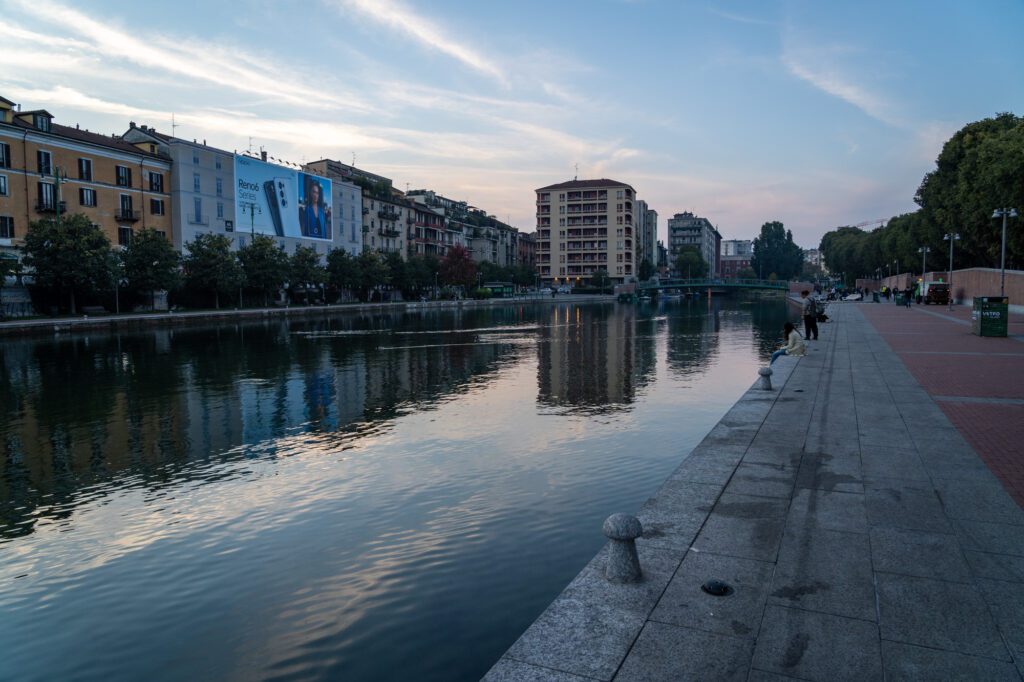
Finish day 2 of this Milan itinerary with dinner and drinks in one of our favorite areas of the city, the Navigli District.
The Navigli District is home to the Navigli (as they’re referred to in Milan), a system of charming canals and canalside walkways in the south of Milan. Yes, Milan has canals too – it’s not just Venice and Amsterdam!
The canals were originally used for irrigation but quickly became a main shipping thoroughfare for transporting goods into the city.
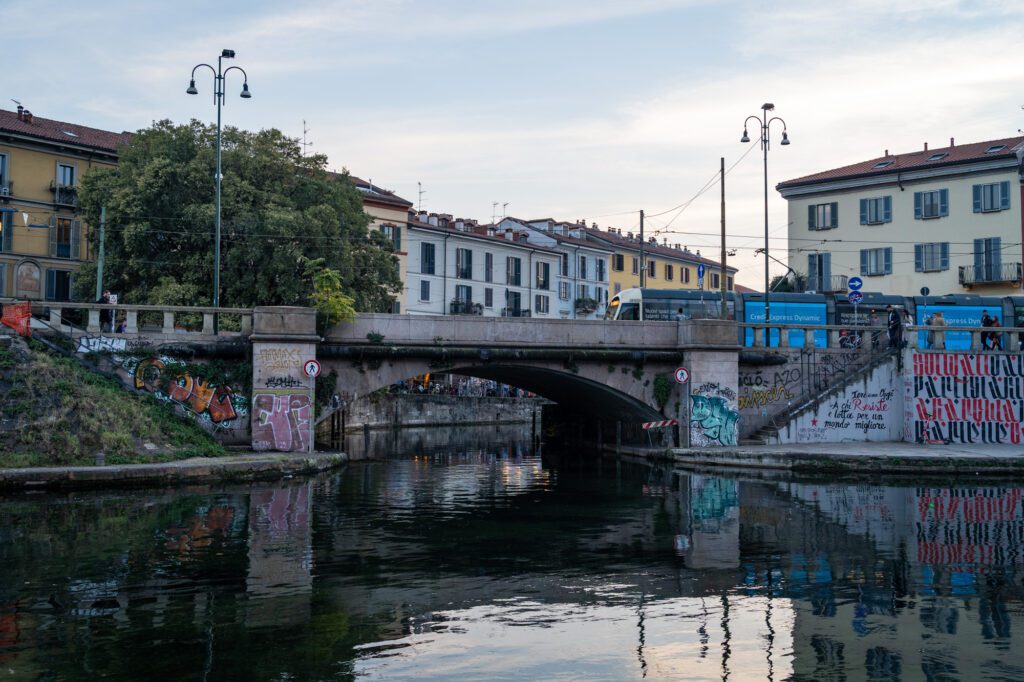
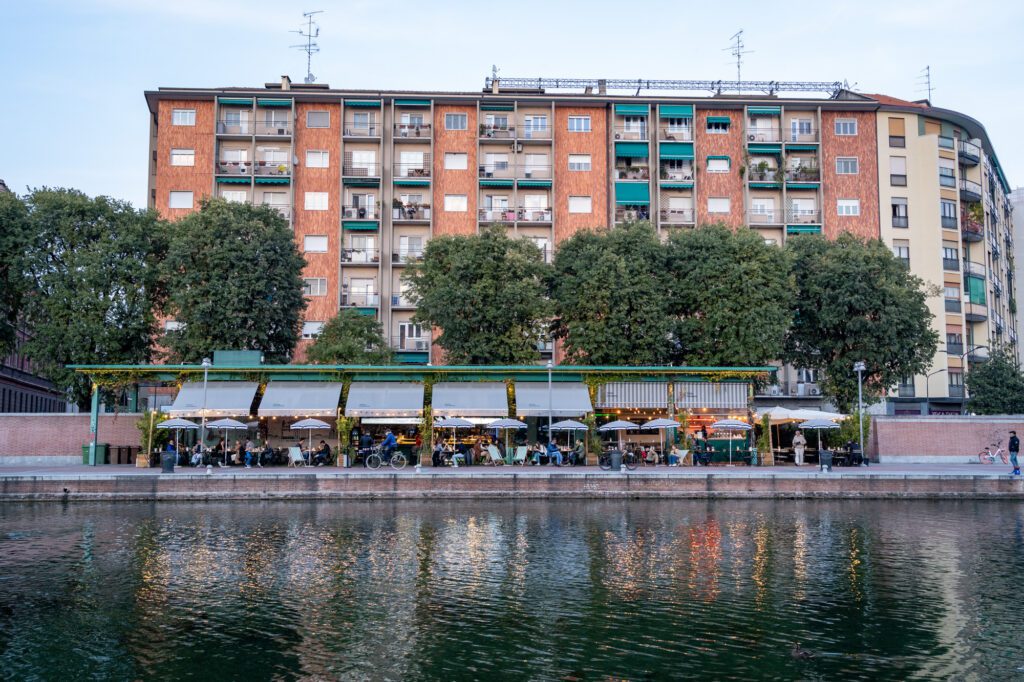
It wasn’t until the mid-20th Century that the canals lost much of their practical importance. Most were filled in, and those that remained simply became a lovely spot to grab a drink by the water.
Start with a stroll around the canals to take in the atmosphere.
We like to begin at the Arco di Porta Ticinese, head west around the Darseno di Milano (a small reservoir), cross over the bridge and down one side of the Naviglio Grande, then come back along the other side.
Then it’s time to enjoy dinner and drinks. There are plenty of places to eat and drink around the canals.
Enoteca Naturale is our favorite spot in Navigli.
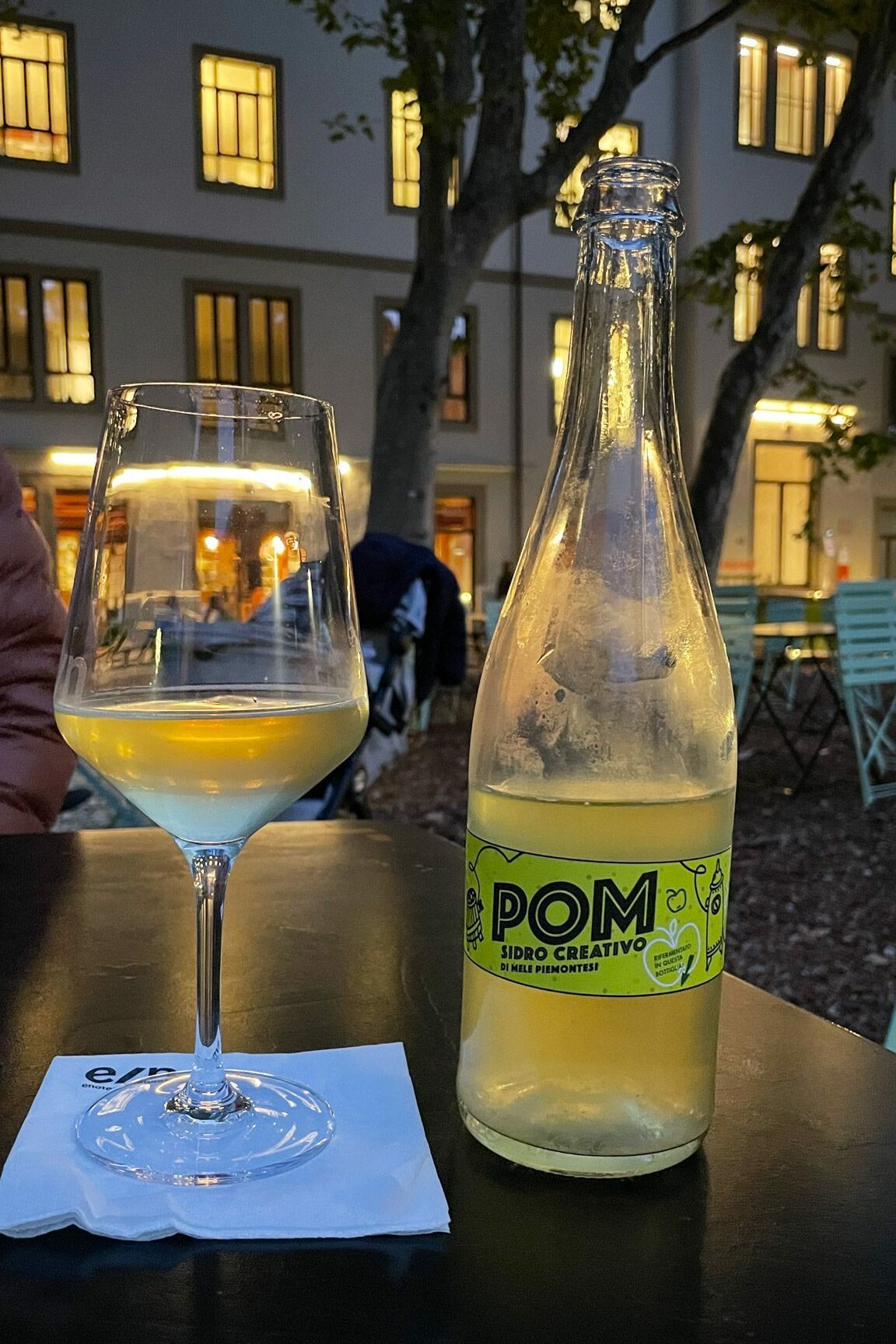
The charming wine bar isn’t actually on the canals, but it is just a few blocks away with a lovely outdoor garden that has views of Basilica di Sant’Eustorgio.
They serve great natural wines by the glass and even have a rotating cider selection. There’s also a menu of small plates to pair with your drinks.
For freshly baked Italian pizza, check out popular Berberè Navigli, while Osteria del Gnocco Fritto on Naviglio Grande specializes in delicious fried dumplings, served with cold meat, cheese, or homemade jam.
For drinks, there’s a series of bars along the north side of the reservoir that offer good views over the water.
There are also plenty of places along either side of Naviglio Grande itself with eager hosts waiting to offer you a table.
What to Do with More Time in Milan
If you have more than 2 days in Milan, here are some more suggestions for ways to extend your trip.
Catch a Game at San Siro
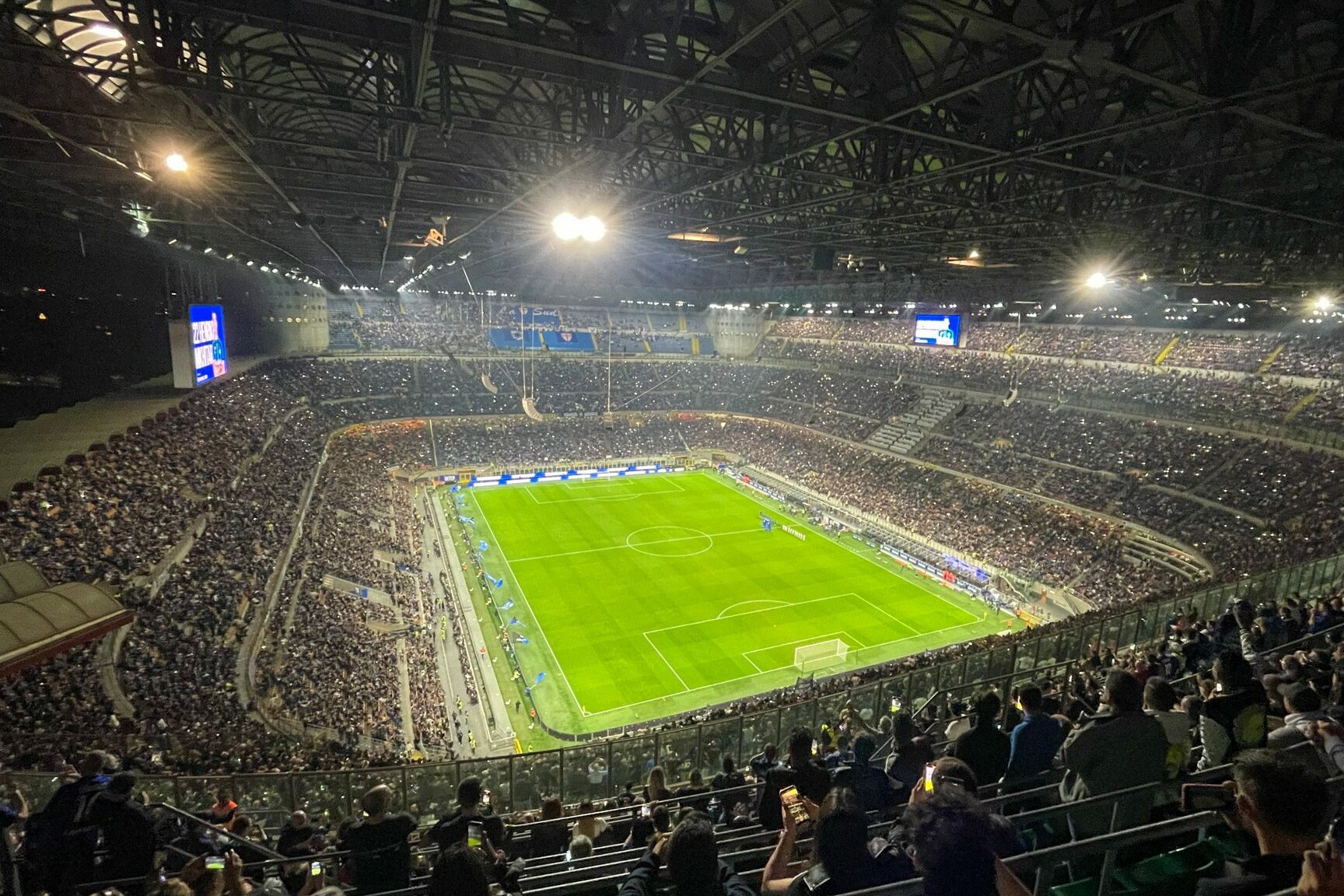
San Siro is one of the world’s most famous soccer stadiums (yes, soccer).
Both of Milan’s very successful teams, AC Milan and Inter Milan (known as “Milan” and “Inter” to locals), play here, and it’s a massive stadium.
If you time your trip right, you may be able to catch a game at the stadium.
My brother and I went to a night game here and the atmosphere was amazing! You can check for upcoming fixtures and buy tickets via the official AC Milan and Inter Milan websites.
If you’re not visiting on a match day, you can still visit San Siro Stadium on a guided tour. Stadium tours include a visit to the stands, locker rooms, mix zone, players’ tunnel, and the field itself.
All tours also include the San Siro Museum, which has a huge collection of jerseys worn by some of the most famous players to ever put on the jersey.
Pinacoteca di Brera
Pinacoteca di Brera is Milan’s main public art gallery, known for its vast collection which features many Italian and foreign artists from the 13th to the 20th Century, including Piero della Francesca, Raphael, and Caravaggio.
The gallery is housed inside a beautiful Baroque palace and was opened in 1809 thanks to Napoleon Bonaparte, who dedicated the museum to the education of students (the Milan Academy of Fine Arts is located on the floor above).
Entrance to the museum costs €15 per adult (€10 reduced) and you’ll need to pre-book a ticket online in advance.
When booking, you’ll be asked to pick the date and time slot you want to visit. Tickets don’t tend to completely sell out in advance, so you can likely wait until relatively close to your visit to book.
A standard ticket also allows you to return to the gallery free of charge for the next 3 months.
We’re big fans of visiting museums and galleries on guided tours, rather than wandering aimlessly on our own. A guided tour adds more depth and allows you to better understand and appreciate what you’re looking at.
Pinacoteca di Brera offers occasional 90-minute English-speaking tours of the gallery, which you can book here for an extra €8 on top of the entrance ticket. But these don’t happen too regularly.
For greater flexibility, this guided tour takes you on a 2-hour journey through the gallery, followed by a walk through Milan’s popular Brera district.
Add a Day Trip to Lake Como or Verona
Milan also makes a great base for taking day trips to other popular destinations in northern Italy, such as Lake Como and Verona.
Lake Como
Lake Como sits just to the north of Milan.
The picturesque lake is known for its stunning landscapes and luxurious villas (and for being Naboo in the Star Wars prequels, of course). It’s also a popular vacation home destination for the world’s rich and famous.
To take a day trip to Lake Como from Milan, you can jump on the train at Milan Centrale to Como San Giovanni in as little as 40 minutes.
From the town of Como on the southwestern tip of the lake, you can then get a fast ferry to explore other prettier towns like Varenna and Bellagio.
Verona
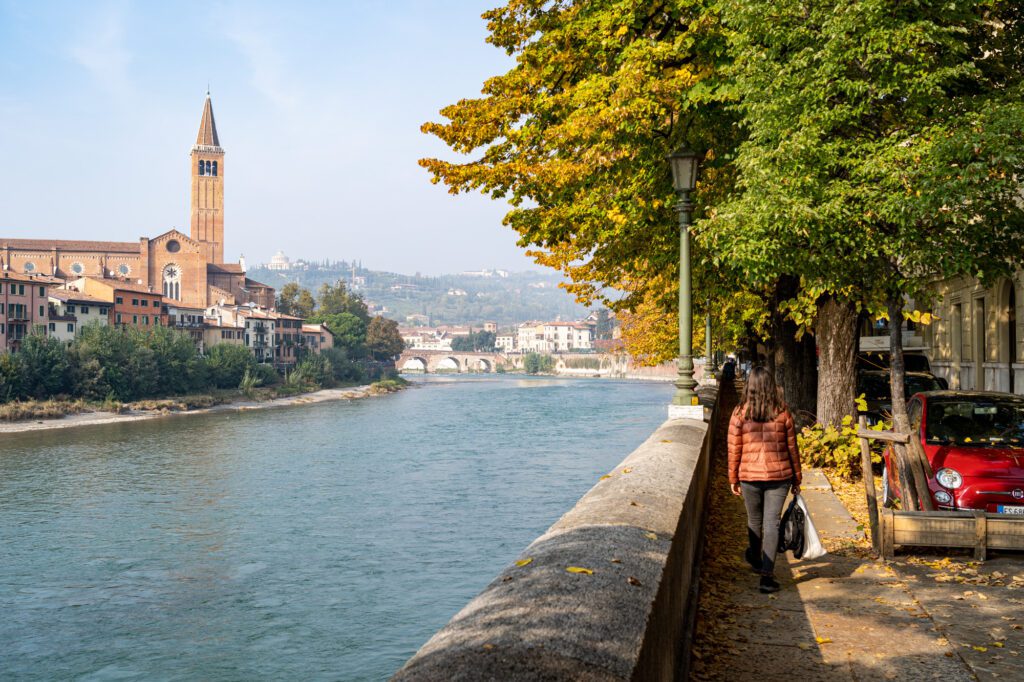
Sitting between Milan and Venice, Verona is a semi hidden gem in northern Italy (at least compared to Milan or Venice) and another great day trip destination.
The historic city is renowned for its well-preserved Roman amphitheater and for being the setting for Shakespeare’s tragic love story of Romeo and Juliet.
Check out our one day Verona itinerary for more inspiration.
Fast trains connect Milan Centrale to Verona Porta Nuova in just 1 hour and 15 minutes regularly throughout the day.
What to Do with Less Time in Milan
If you do end up with less than two days, it is still possible to see some of the city’s highlights.
To condense this Milan itinerary into one day, we’d suggest focusing your time on four main things; The Duomo Terraces, The Last Supper, Castello Sforzesco + Parco Sempione, and Naviglio Grande. It will be a busy day, but it’s doable.
Check out our one day Milan itinerary for a more detailed rundown of how to fit all of these into 24 hours.
Getting Around Milan
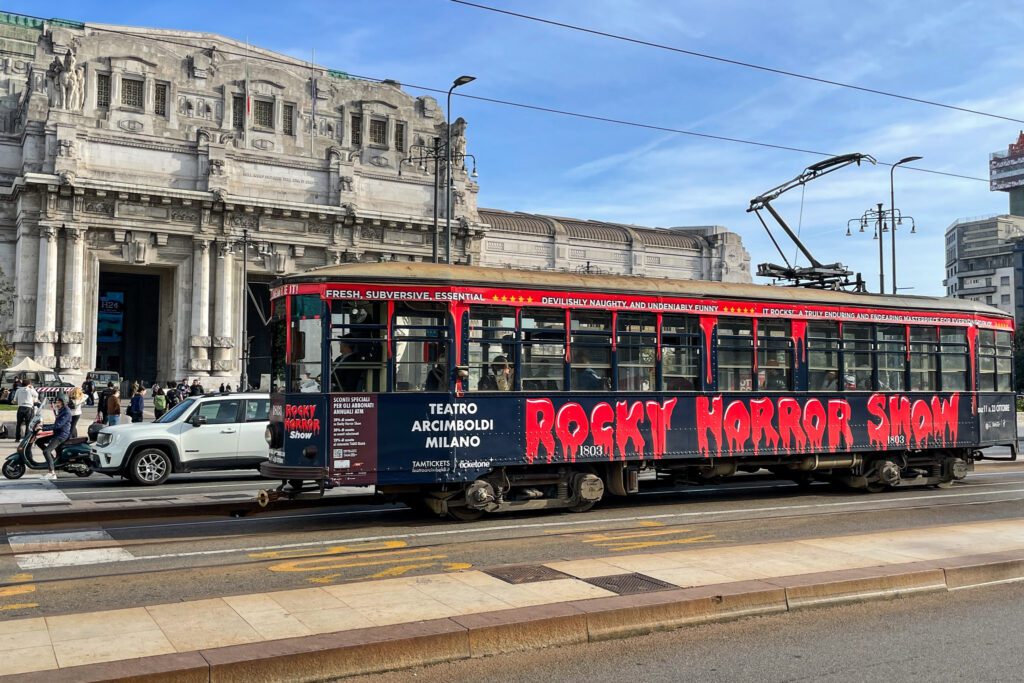
Look, we love to walk when we’re traveling, and are often hitting 25,000 steps a day when we’re visiting new cities.
Walking is a great way to explore this Italian city. But because Milan is such a big modern city, if you want to see the best of Milan in 2 days, you’re probably going to want to make the most of public transportation too.
Milan offers three main forms of public transportation – trams, metro, and buses. Each covers different parts of the city and runs frequently throughout the day.
- Trams: Trams are a popular way to move around Milan, especially in the city center. They are convenient for short distances and offer a scenic view of the city along the way.
- Metro: The Milan Metro is an extensive underground system connecting various neighborhoods. It’s the fastest way to travel longer distances.
- Buses: Buses complement the tram and metro network, reaching areas that are not accessible by these other forms of public transport. Over two days, you probably won’t actually take a bus because the center of Milan is well covered by trams and the metro.
All three forms of transportation in Milan city center use the same ticketing system, with a single ticket costing €2.20 (valid for 90 minutes after first validation).
However – and this is probably the biggest tip we have in this entire block of logistics sections – if you’re going to use public transportation, it is almost certainly worth buying a transportation pass.
After trying to do everything on foot on our first trip (and having a hard time because it’s so big), I made a beeline for the ticket machines to get my unlimited transportation pass when I landed in Milan on my next trip.
A 24-hour Milan transportation pass costs €7.60, while a 3-day pass costs €13. So it’s still cheaper to buy a 3-day pass rather than two 24-hour day passes for a 48-hour trip.
You’ll only need to use public transport four times each day to make the ticket worthwhile. For context, we used public transportation 12 different times in 24 hours (when my mom and brother were with me on our last trip), so it was easily worth the money.
Pro Tip: Download the ATM Milano Official App to plan your route and see schedules (though we found Google Maps to be plenty reliable too).
Getting from MXP to Milan
As a quick reminder, there are two main airports we’d recommend arriving at in Milan; MXP and LIN.
Milan Malpensa International Airport (MXP) is the largest of the two and serves mostly international carriers.
Milan Linate (LIN) is closer to the city center but mainly caters to domestic and European flights.
There’s also Milan Bergamo Airport (BGY), another large international airport to the northeast of Milan which serves budget airlines.
We’d suggest avoiding this one if possible. The airport is far from Milan (as in, in a different city) and transportation into the city center is significantly more limited than from MXP and LIN.
Milan Malpensa Airport (MXP) sits 50 km (31 miles) from Milan.
The easiest way to reach the city center is by taking the Malpensa Express Train. The train costs €13 one-way and runs every 15-30 minutes throughout the day.
And, to be honest, there’s no reason to NOT take the train unless you’re arriving in the brief window where it’s not running in the early morning.
The Malpensa Express runs two routes from the airport; one to Milano Centrale and one to Milano Cadorna.
The trains don’t serve both stations, so make sure to figure out which is closer to your accommodation before boarding either train.
The journey to Cadorna takes approximately 37 minutes, while the journey to Centrale takes about 50 minutes (depending on the time of day and route).
Other Options for Traveling Between MXP and Milan:
- Regional Train – There are also regional trains that run from Malpensa Airport station into Milan (such as the Trenord R28). These tend to be cheaper than the Malpensa Express but make more stops so take longer.
- Bus – The Autostradale 143 bus runs regularly between the airport and the city and takes around an hour. The bus is the cheapest option, with tickets costing €10 one-way or €16 round trip (you have to buy the round trip ticket on arrival and use it when you leave).
- Taxi – If you arrive at Malpensa between 1:00am and 5:00am, a taxi may be your only option. The journey takes about 50 minutes and you can expect to pay around €100.
Getting from LIN to Milan
Milan Linate Airport (LIN) is located just 7 km (4.3 miles) from Milan city center.
The quickest way to reach the city center from LIN airport is by jumping on metro line M4.
The M4 runs to San Babila Station in downtown Milan in just 12 minutes. From here, you can hop onto another line or bus to reach your accommodation.
There are also a bunch of public buses connecting LIN to various areas of Milan, as well as an Airport Bus Express running to Milan Central Station in 25 minutes.
Heading to Italy?
We’ve been to Italy multiple times – obviously we love it – including more than a month on our last trip!
If you enjoyed this guide and found it helpful, you definitely won’t want to miss our detailed guide to planning an amazing 10 Day Italy itinerary, which covers Rome, Florence, and Venice and is perfect for a first trip.
We also have a guide to spending two weeks in Italy, which combines those three main cities with a few lesser known cities (Bologna and Verona), or a guide to spending one week in Italy, which has six different ways to spend 7 days.
Here are some of our other Italy guides to help you plan an incredible Italian adventure.
Rome:
- 4 Days in Rome: A Perfect Rome Itinerary for First Timers
- Where to Stay in Rome: A Complete Guide to Rome’s Best Areas to Stay
- The Best Things to Do in Rome (Not Just a List of Attractions!)
Florence:
- 3 Days in Florence: How to Explore the Fascinating Tuscan City in 3 Days
- One Day in Florence: How to See the Best of Florence in 24 Hours
- Where to Stay in Florence: A Complete Neighborhood Guide
- What to Do in Florence: A Detailed Guide to the Best Things to Do
- 9 Spectacular Day Trips from Florence to Add to Your Itinerary
- Exactly Where to Find the Best Coffee in Florence
Venice & Milan:
- 2 Days in Venice: How to Plan a Perfect 48 Hours Exploring Venice
- One Day in Milan: How to See the Best of Milan in a Day (Duomo + Last Supper)
- 2 Days in Milan: How to Plan an Amazing Milan Itinerary
- One Day in Verona: A Perfect Day in Verona, Italy’s Most Charming City
Cinque Terre:
- The Best Things to Do in Cinque Terre: A Complete Guide
- How to Plan an Amazing 2 Day Cinque Terre Itinerary
- Where to Stay in Cinque Terre: The 4 Best Places to Stay (with Pros and Cons for Each)
Sicily:
Need to Eat Gluten Free in Italy?
If you’re traveling and need to eat gluten free like me, Matt (I have Celiac Disease, which is why I started this site in the first place), then you’ll want to check out our gluten free guide to Italy.
Then head over to our city guides for Rome, Florence, and Milan to help you find the best gluten free pastries, pizzas, and more so that you can eat like a king/queen even with Celiac Disease.

I had booked La Scala tickets months ago but had not got around to anything else until a week before our trip to Milan. For some reason I opened up your website. SOOOOOO very helpful and although everything nearly booked managed to get a tour to include The Last Supper and also tickets direct with the Duomo.
It was so much better than a dry Book of the sights. thank you
Thanks for the kind words! Glad to hear you found it helpful, and that you were able to snag some tickets to those hard-to-get attractions (and, presumably, that you enjoyed Milan). Cheers!